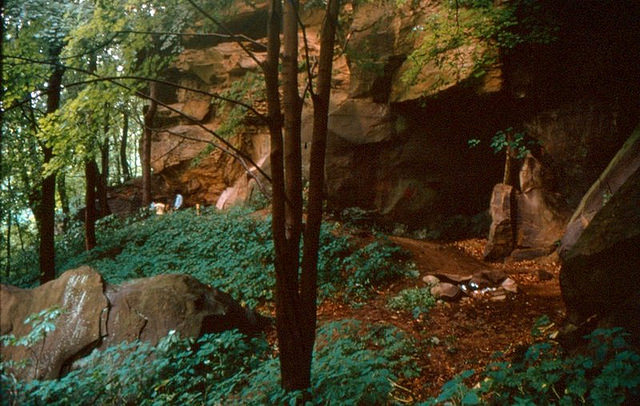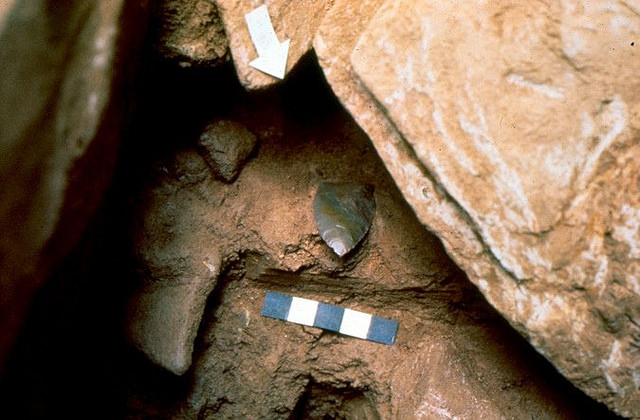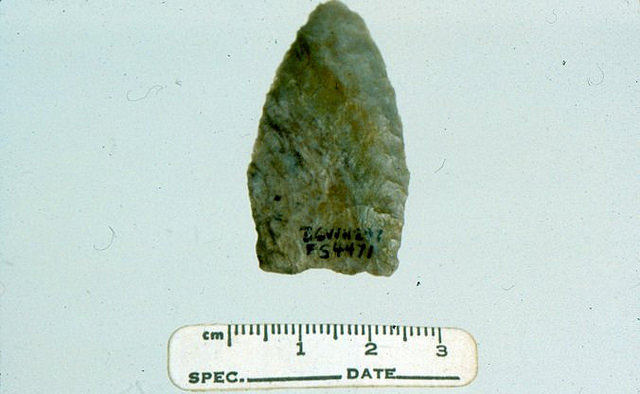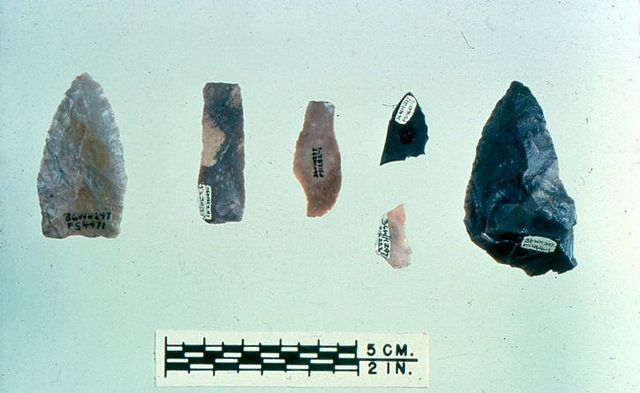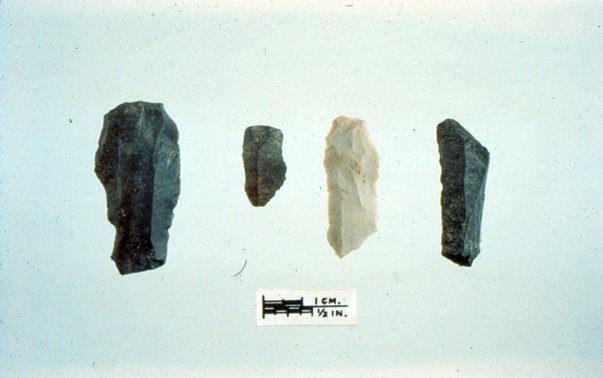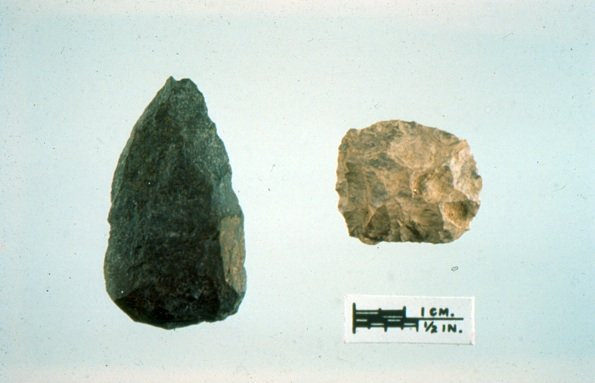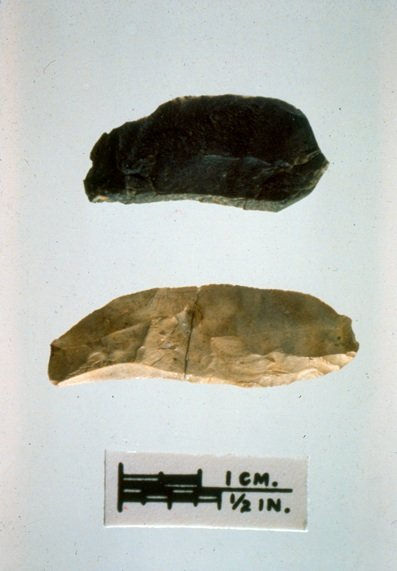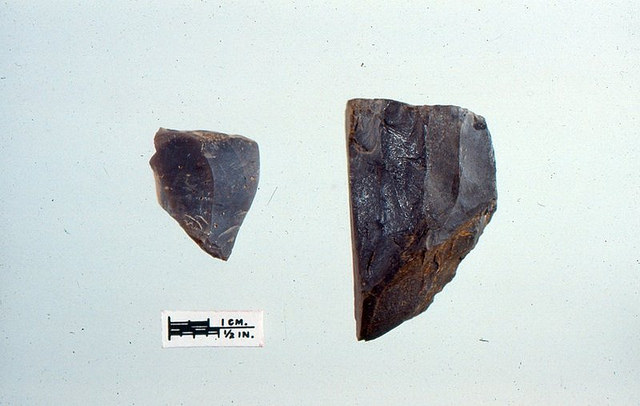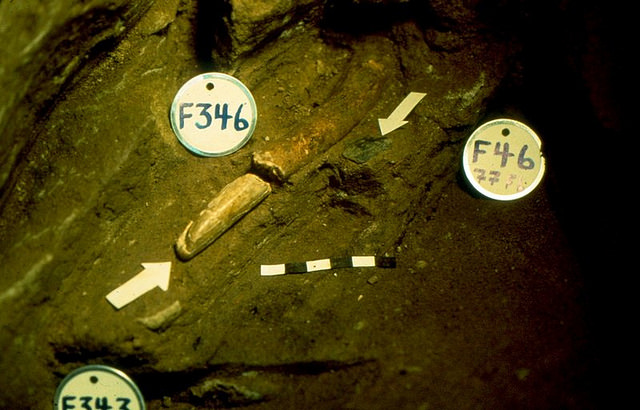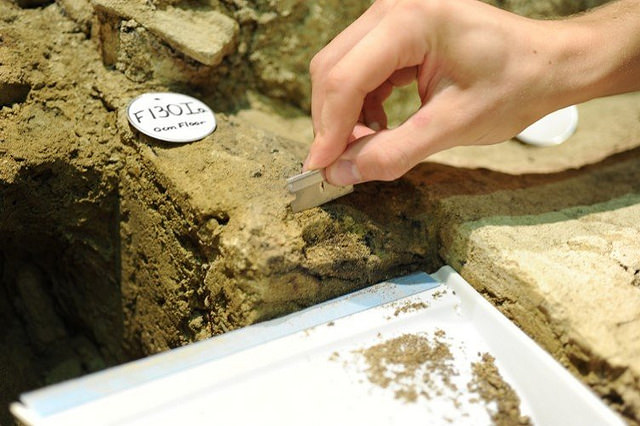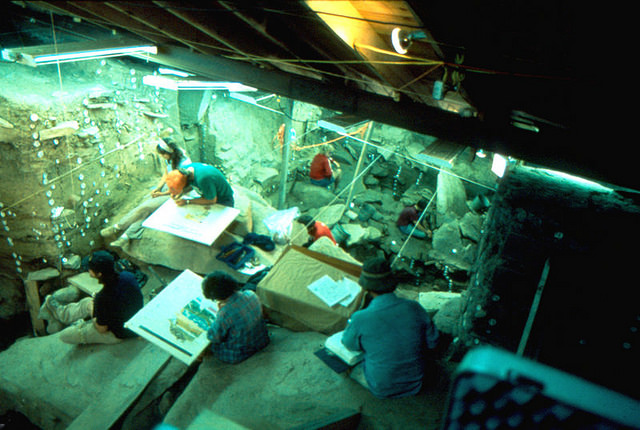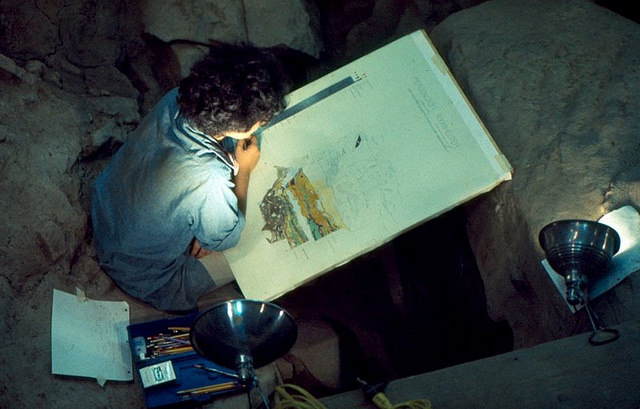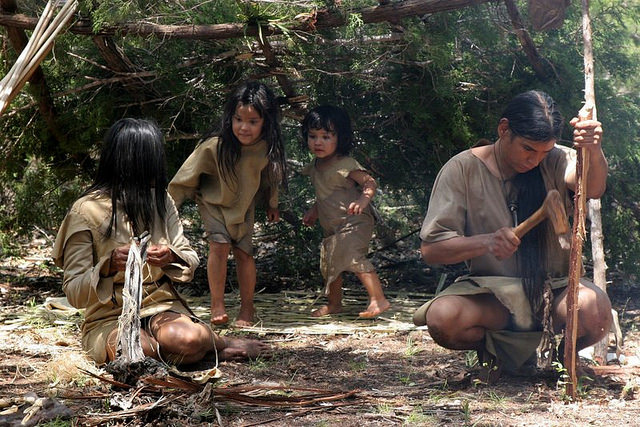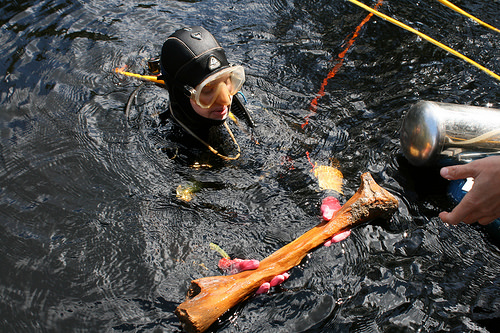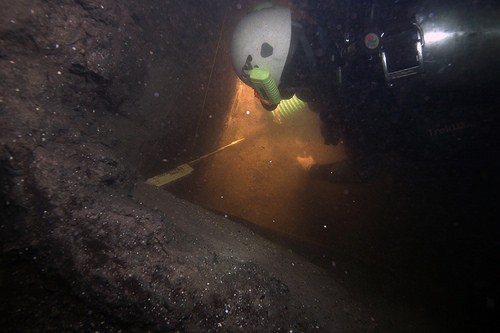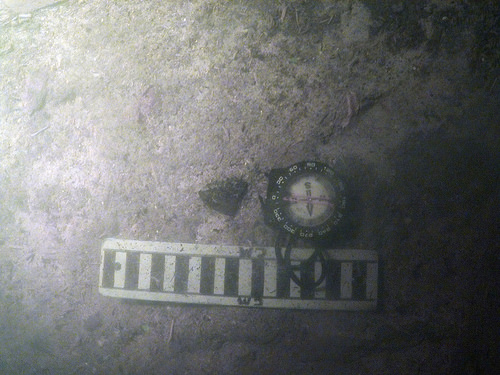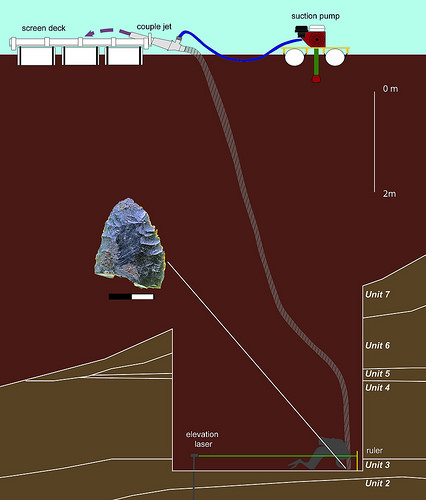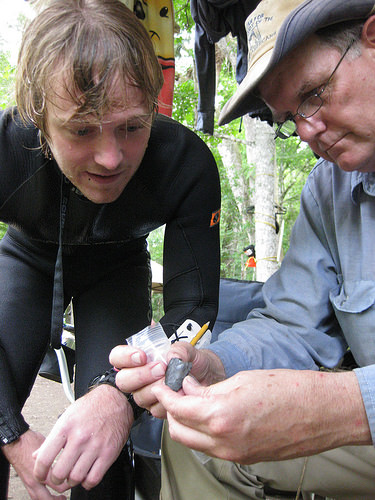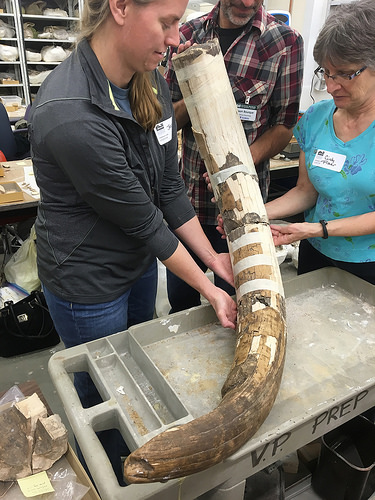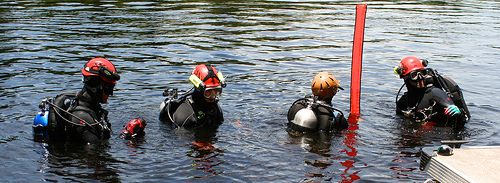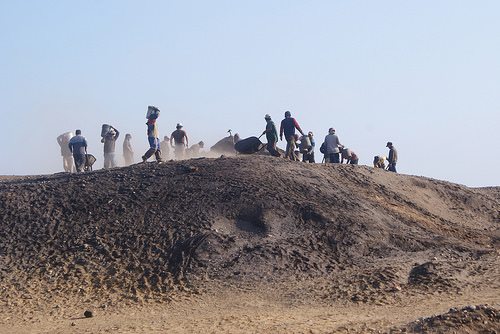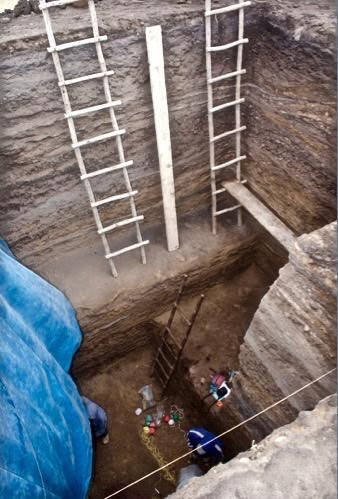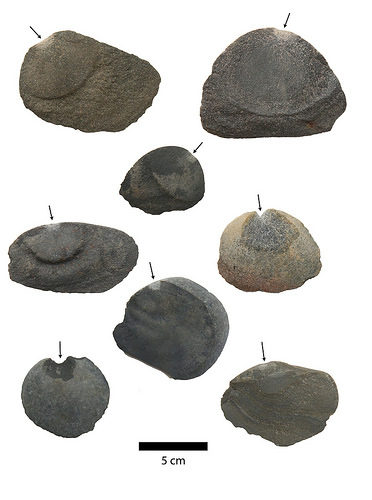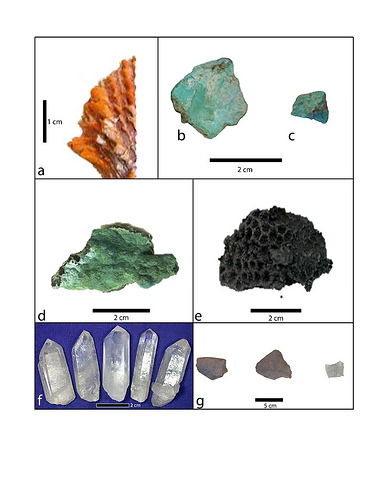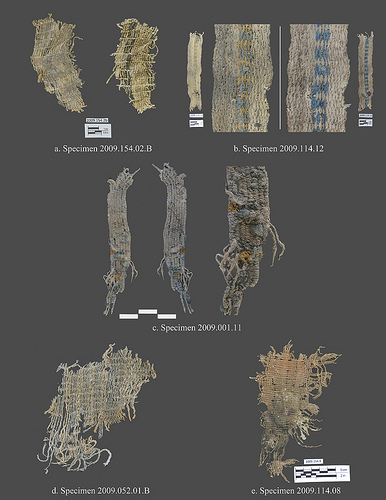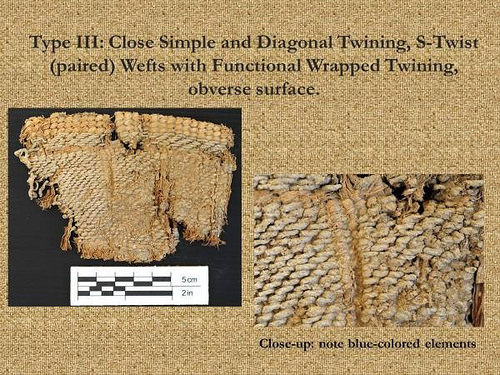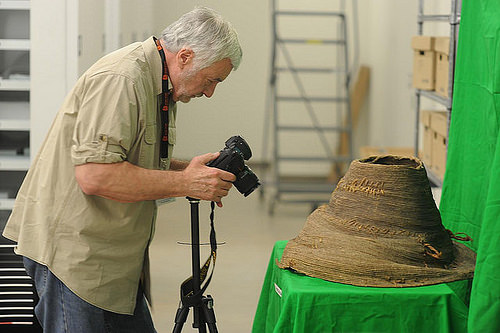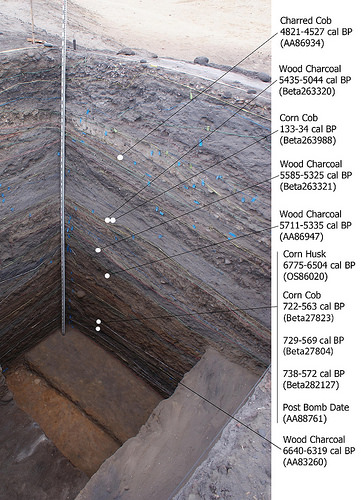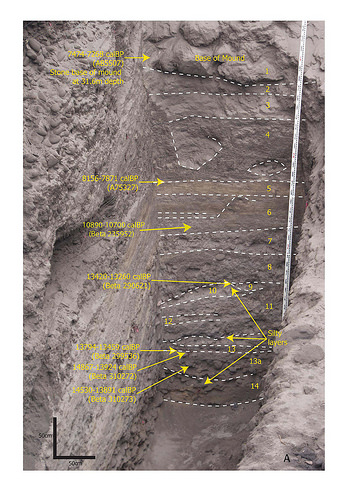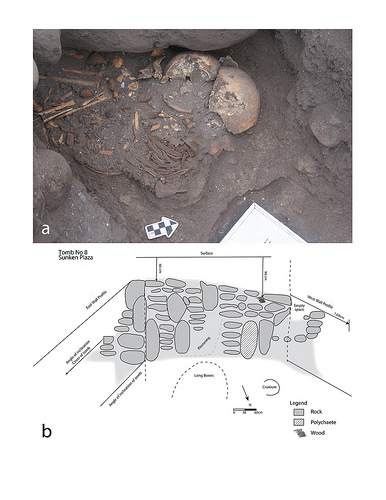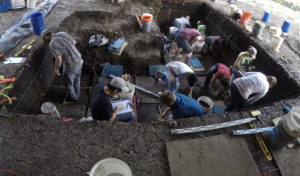
It was once called Nipéhe, an ancient village site of the Nez Perce Tribe. Located at the confluence of Rock Creek and the lower Salmon River in western Idaho, this spot also saw bands of Paleoindians sojourneying here thousands of years ago. Long since abandoned as a modern world has moved in, it is today called Cooper’s Ferry, a location known to few. But this place has acquired a very special meaning to a team of archaeologists and student volunteers led by Loren Davis of Oregon State University. They have been excavating here for ten years, and the results of their efforts have been nothing less than remarkable: during the last two years, they discovered lithic artifacts (stone tools) in the lowest excavation layers—radiocarbon-dated to between 15,280 and 16,560 years ago. Thus far, the deposits have revealed hundreds of objects, including stone tools; fire-cracked rock; charcoal; and animal bone fragments, including tooth fragments from an extinct species of horse that lived in North America at the end of the last glaciation. Most significantly, according to Davis, Cooper’s Ferry is the “oldest radiocarbon-dated site in North America that includes artifacts associated with the bones of extinct animals”.*
Because of the age of the findings, Davis and the team are suggesting some tantalizingly specific implications about how and when humans settled North America. “Early peoples moving south along the Pacific coast would have encountered the Columbia River as the first place below the glaciers where they could easily walk and paddle in to North America,” said Davis. “Essentially, the Columbia River corridor was the first off-ramp of a Pacific coast migration route. The timing and position of the Cooper’s Ferry site is consistent with and most easily explained as the result of an early Pacific coastal migration.”*
Coopers Ferry is also included among a small but growing number of sites across the Americas that are revealing evidence of human occupation significantly before 13,000 years ago, the time when the Clovis culture, long thought to have been the most ancient Paleoindian culture in the Americas, emerged.
___________________________
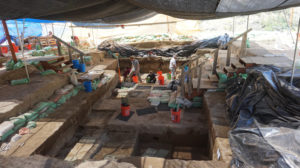
Cooper’s Ferry site excavations in progress in 2018. Loren Davis, Oregon State University
___________________________
About 2,000 miles due east of Cooper’s Ferry, Devlin Gandy, an archaeologist from St. John’s College at the University of Cambridge, dons a hazmat suit, multiple hairnets, and a respirator and proceeds to incise into a vertical profile of sediment with a scalpel to extract a cube of an ancient deposit before placing it carefully into a centrifuge vial. The sediment cube sample comes from what has been dubbed the “deep hole”, consisting of some of the earliest and deepest excavated cultural layers within the famous site of Meadowcroft Rockshelter, located within a remote forested area of the western Pennsylvania Appalachian region. Meadowcroft is long known to have produced evidence of what some scientists arguably suggest to be the earliest presence of humans in North America — an occupation that goes back at least 16,000 years ago. The purpose of the sampling, among other things, is to test the possible presence of human DNA still remaining in the soil, left there by human occupiers who may have lived and worked there at that early time. The sampling was sent to the Centre for Geogenetics in Copenhagen, Denmark, where, at this writing, they are being systematically tested.
“The site remains as one of the first serious challenges to the formerly prevailing Clovis First model and also clearly indicates that among the first inhabitants of the New World were broad-spectrum foragers rather than focused big game hunters,” says James Adovasio, the archaeologist who led excavations at the site. “The early assemblage from Meadowcroft is now seen to have analogs at Cactus Hill, Virginia, as well as several sites on the Delmarva Peninsula of Maryland.”
Adovasio makes clear that he is not hanging his hat on the sample testing results. “We stress that the absence of any human, animal, or plant DNA in no way undermines previous conclusions about the site,” he emphasizes. The archaeological investigations have historically churned up too much other data to be overturned by any new, single sampling. Moreover, investigations are not finished. “More than one-third of the site remains unexcavated,” Adovasio adds. But there are no plans to conduct on-site investigations in the immediate future.
_________________________
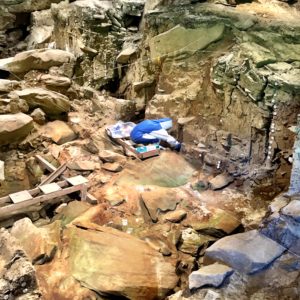
Above and below: Collecting the deposit sampling within the Meadowcroft Rockshelter for testing . Courtesy James Adovasio
_________________________
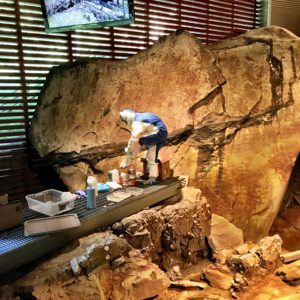
_________________________
Across North and South America — north, south, east, and west — a new narrative is emerging about the discovery of artifacts and other finds that are radically re-shaping the traditional paradigm of the early settling of the Americas. What follows is a consolidation of major feature articles that have appeared in Popular Archaeology over the past few years, stories that are helping to inform a complex new narrative.
*Archaeological site reveals humans arrived in the Americas more than 16,000 years ago, Aug. 29, 2019. American Association for the Advancement of Science. https://popular-archaeology.com/article/archaeological-site-reveals-humans-arrived-in-the-americas-more-than-16000-years-ago/
____________________________
Exploring Early Americans at Friedkin, and More
By Michael Gordon
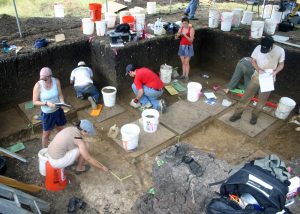
Excavations at the 15,000-year-old Friedkin site in 2016. Image courtesy Michael R. Waters and Center for the Study of the First Americans, Texas A&M University
____________________________
Few had ever heard of the little town of Buttermilk Creek, Texas, until it was placed on the map in early 2011 when Texas A&M University anthropologist Michael Waters made his public announcement. He and a team of archaeologists, researchers, students and volunteers had been painstakingly excavating at an archaeological site, known as the Debra L. Firiedkin site, for years. What they discovered there had generated excitement in the world of American archaeology.
Yielding a prolific assemblage of artifacts, the Buttermilk Creek Complex, as researchers are now calling it, contained evidence of small blades, choppers and scrapers, implements made by people who had long departed the scene, long before any notion in the minds of the early European explorers that anyone had ever inhabited the North American continent.
“Most of these are chipping debris from the making and resharpening of tools,” said Waters, “but over 50 are tools. There are bifacial artifacts that tell us they were making projectile points and knives at the site. There are expediently made tools and blades that were used for cutting and scraping.”
On the face of it, his discovery could hardly eclipse any of the finds made by other archaeologists through decades of excavation and research about the early peopling of the Americas. But there were several important differences that made the site, and the finds, unique. They had to do with the sheer number of the finds, their nature, and the dating, with the most sensational difference being the dating.
“What is special about the Debra L. Friedkin site is that it has the largest number of artifacts dating to the pre-Clovis time period, that these artifacts show an array of different technologies, and that these artifacts date to a very early time,” said Waters.
The Clovis time refers to a time period (beginning about 13,500 years ago) to which, according to many scholars, the earliest known stone tools and weapons made by early ancestral Native Americans could be assigned. Best known for their medium to large fluted lanceolate projectile points and distinctive bone and ivory items, these stone artifact finds constitute the evidential basis for the widely accepted “Clovis First” hypothesis, which suggests that the people associated with the artifacts were the first inhabitants of the Americas. Clovis artifacts have been found in abundance at sites across the North American continent.
But the headline-making finds at the Friedkin site were not Clovis, and they were older than the oldest known Clovis tools by about 2,000 years.
Waters and his associates used Optically Stimulated Luminescence (OSL) dating, a technique that measures the amount of light energy trapped over thousands of years in minerals within the sediment surrounding artifacts. Professor Steven Forman of the University of Illinois at Chicago worked with Waters at the site, collecting 50 core samples from two sites at Buttermilk Creek for testing. “We found Buttermilk Creek to be about 15,500 years ago — a few thousand years before Clovis” said Forman. “We dated the sediments by a variety of optical methods. We also dated different mineral fractions as well, and we consistently got the same ages. We looked at the age structure of the sediment by many different ways and got the same answers.”
In addition to providing compelling evidence for pushing the clock back on when the earliest Americans arrived, the Friedkin site findings have provided additional credence to the suggestion that the stone tool technology of the Clovis culture was not imported into the Americas via the Bering Land Bridge (“Beringia”) in accordance with the Clovis Model, but instead evolved in North America from an earlier technology. Given the nature and characteristics of the Buttermilk Creek Complex, Waters maintains that the Complex represents a “type of assemblage from which the Clovis assemblage could emerge” with the new dating providing “ample time for people to settle into the environments of North America, colonize South America by at least ~14.1 to 14.6 ka, develop the Clovis tool kit, and create a base population through which Clovis technology could spread”.[1]
________________________________________________________________________________________
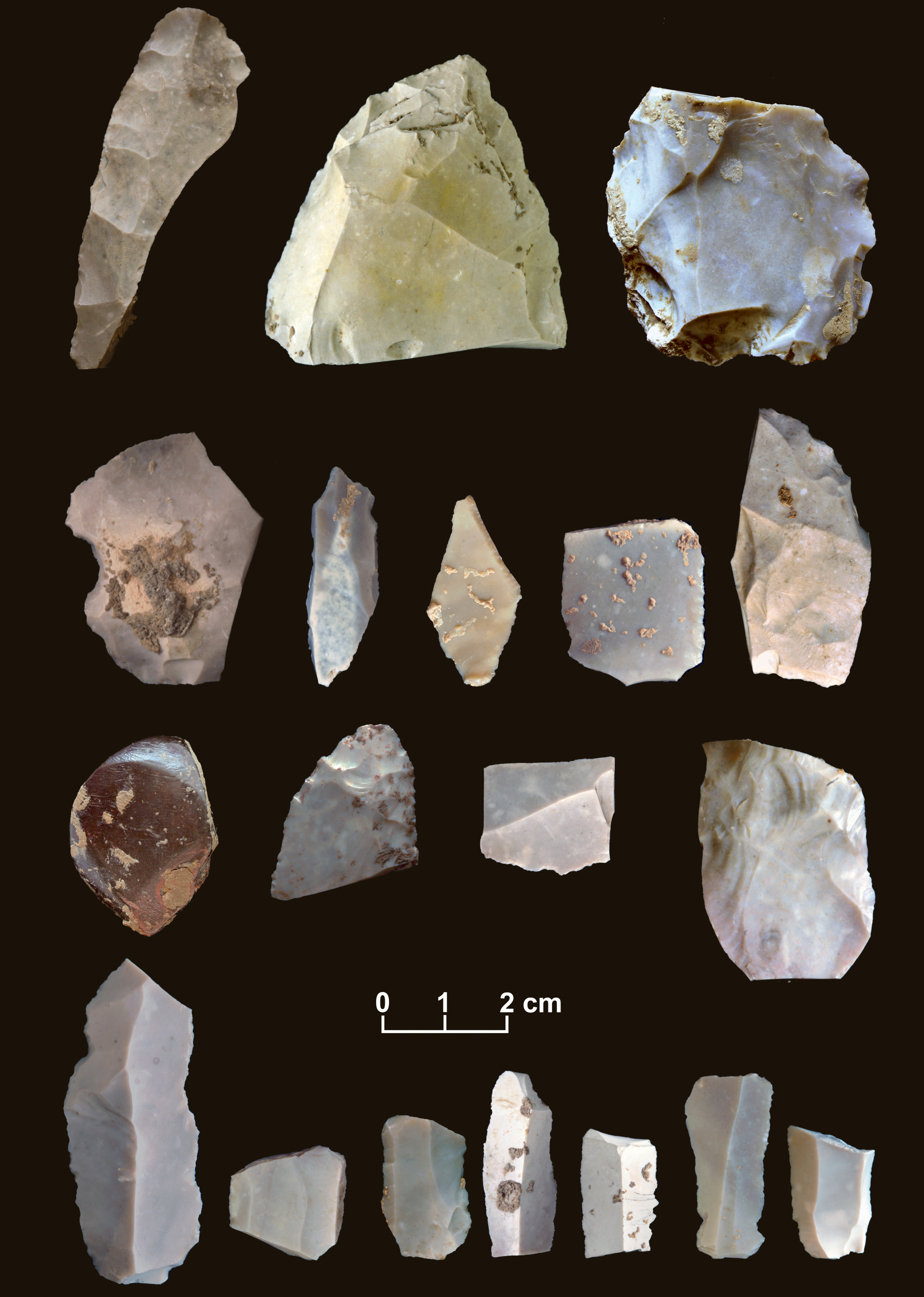
Some of the artifacts from the 15,500-year-old horizon. Image courtesy Michael R. Waters.
_______________________________
The Mounting Evidence
The arguments against the traditional Clovis First perspective point to the fact that no Clovis-type artifacts have been found in Northeast Asia, from where the early Americans under the Clovis Model are suggested to have migrated, and fluted stone points that are iconic for Clovis and found in Alaska are all dated too late to be assigned to the Clovis horizon. Moreover, six major sites in South America with stratigraphic layers dated to the Clovis period are devoid of Clovis period artifacts.
Nevertheless, comparing the evidence of Clovis technology dated to very early occupation of the Americas with what is available for the same time period for other technology forms had traditionally given Clovis the decided edge in the debate. But new evidence against Clovis has been mounting. The Friedkin site is not the only site that has been dated to the pre-Clovis time period. Pre-Clovis finds have been recorded at sites such as Pedra Furada in Brazil, Monte Verde in Chile, two mammoth kill sites in Wisconsin, Topper in South Carolina, Cactus Hill and Saltville in Virginia, and Meadowcroft in Pennsylvania, among others. The evidence at these sites, however, has been in dispute and is not as robust as that found at Friedkin.
________________________________________________________________________________________ 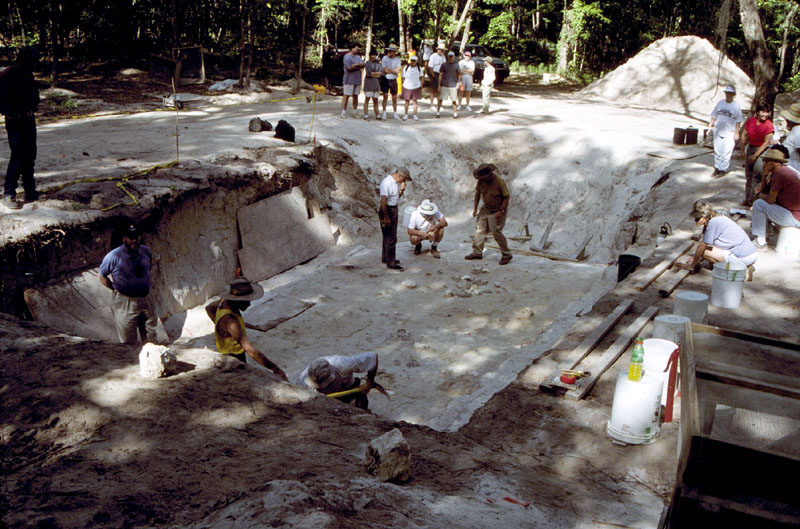
Excavators examine a cluster on the proposed pre-Clovis surface at the Topper site. Courtesy Center for the Study of the First Americans.
_______________________________
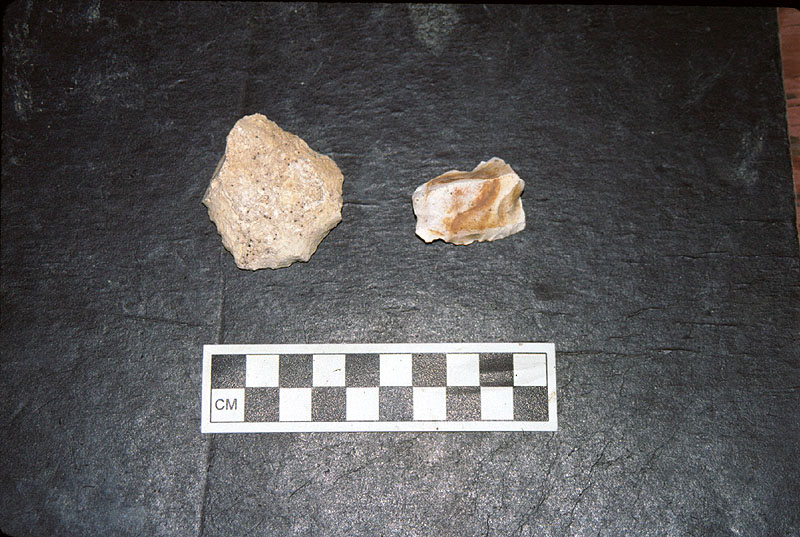
Proposed pre-Clovis artifacts found at the Topper site. Courtesy Center for the Study of the First Americans.
__________________________________
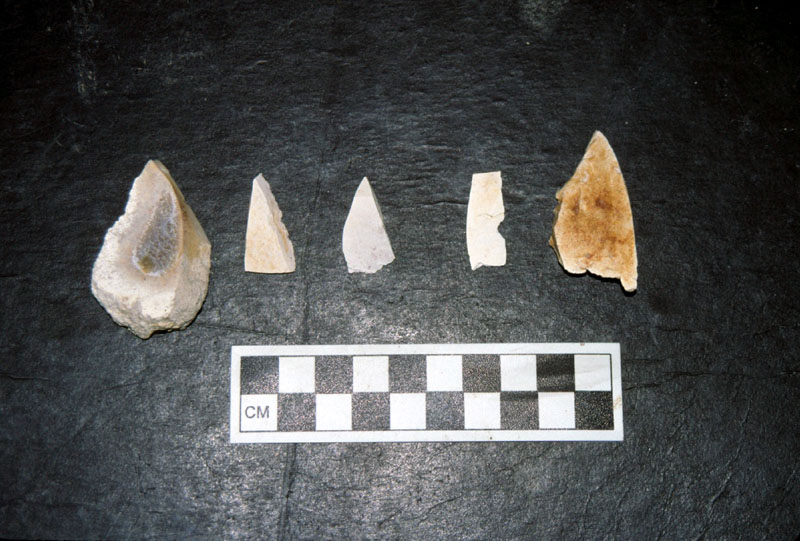
Proposed pre-Clovis bend break tools found at the Topper site. Courtesy Center for the Study of the First Americans.
______________________________
But new discoveries have emerged and joined Friedkin with stronger evidence of pre-Clovis beginnings…….
At the Paisley caves in south-central Oregon, a team of research scientists led by Dennis L. Jenkins of the University of Oregon’s Museum of Natural and Cultural History found evidence that an early stone implement technology, known as “Western Stemmed” projectile points (darts or thrusting spearheads), were manufactured at least 11,070 to 11,340 radiocarbon years ago, making them concurrent with or possibly earlier than the Clovis culture (dated to 13,000 calendar years ago). The researchers obtained 190 radiocarbon dates on artifacts, human coprolites (dried feces), bones and sagebrush twigs within layers of silt deposited over thousands of years in the caves. The broad, concave-based, fluted Clovis projectile points often associated with early Americans who lived about 12,000 – 13,000 years ago were not found in the caves.
Past studies of the Paisley Caves have also reported very early dates from human coprolites with ancient DNA, but questions arose about whether those samples could have been contaminated, and whether they were found in true context with artifacts from the same era. So the researchers did an exhaustive examination of the stratigraphy, which is one of Loren Davis’ specialties. Davis was a member of the archaeological team investigating Paisley.
“We continued to excavate Paisley Caves from 2009 through 2011,” the authors wrote in Science. “To resolve the question of stratigraphic integrity, we acquired 121 new AMS [accelerator mass spectrometry] radiocarbon dates on samples of terrestrial plants, macrofossils from coprolites, bone collagen and water soluble extracts recovered from each of these categories. To date, a total of 190 radiocarbon dates have been produced from the Paisley Caves.”
Davis conducted microscopic analysis of the soil using a “petrographic” microscope, to eliminate any indications that liquid – such as water or urine from humans or animals – may have moved down from higher layers into the lower layers, thus “contaminating” or compromising the integrity of the dating of the soil. They also analyzed the silt where the stem points were found and bracketed above and below those layers to determine if the radiocarbon dates synchronized.
The result: “The stemmed points were in great context,” Davis said. “There is no doubt that they were in primary context, associated with excellent radiocarbon dates.” The new dating was valid and few could now argue with the results.
The significance of the Paisley finds extends from the fact that Western Stemmed points and Clovis points differ fundamentally in terms of their hafting portions, the part of the stone point that connects to a shaft. Stemmed points are narrower or constricted at their bases, whereas the hafting portions of Clovis points are not narrow, but thinned width-wise through removal of large flakes from their bases.
“These two approaches to making projectile points were really quite different,” Davis said, “and the fact that Western Stemmed point-makers fully overlap, or even pre-date Clovis point makers likely means that Clovis peoples were not the sole founding population of the Americas.”
“From our dating, it appears to be impossible to derive Western Stemmed points from a proto-Clovis tradition,” Jenkins said. “It suggests that we may have here in the Western United States a tradition that is at least as old as Clovis, and quite possibly older. We seem to have two different traditions co-existing in the United States that did not blend for a period of hundreds of years.”
It is interesting to note in this context that Clovis technology has only been found in the New World, whereas Western Stemmed technology is similar to stone technology seen in northeastern Asia.
At least three other Western sites, including Cooper’s Ferry in Idaho, Smith Creek Cave in Nevada, and Bonneville Estates Rockshelter, also in Nevada, also contain only Western Stemmed points in deposits of this early time period.
_________________________________________________________________________________________
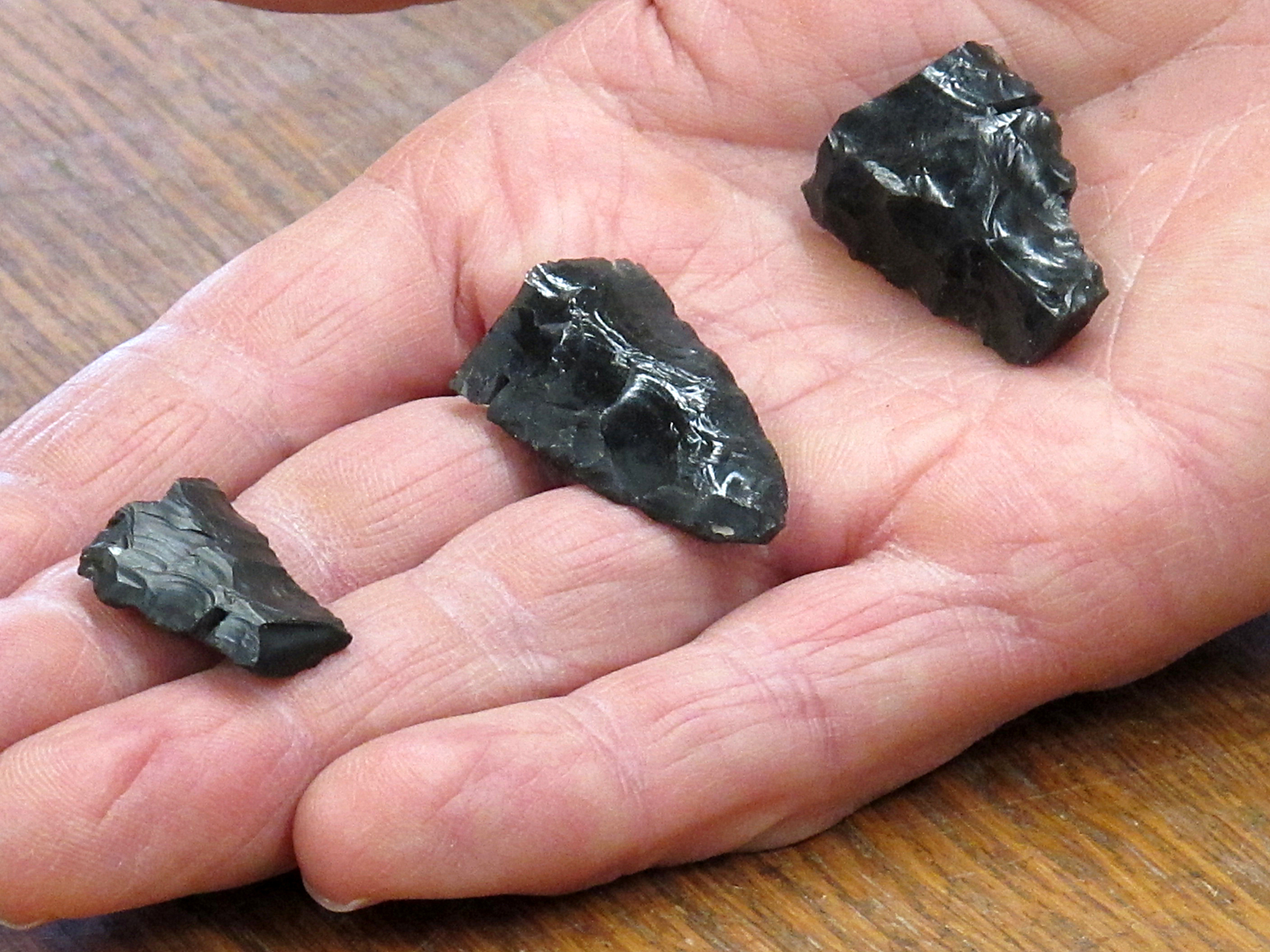 Displayed in the hand of University of Oregon archaeologist Dennis Jenkins are three bases for Western Stemmed projectiles from the Paisley Caves in Oregon. The bases date to some 13,000 years ago. [Photo by Jim Barlow]
Displayed in the hand of University of Oregon archaeologist Dennis Jenkins are three bases for Western Stemmed projectiles from the Paisley Caves in Oregon. The bases date to some 13,000 years ago. [Photo by Jim Barlow]
________________________________
Enter here another site, located in Manis, Washington, where the fossil remains of a mastodon were excavated by Dr. Carl Gustafson and a team from Washington State University in the 1970’s. He concluded from radiocarbon dating of charcoal deposits around the remains that it was about 14,000 years old. It was a conclusion that had been the subject of considerable debate among scholarly critics, particularly as he maintained that a bone point found embedded in the rib bone of the mastodon was an early projectile point, similar to other bone projectile points found at other Paleoindian sites.
The case was revisited recently when Dr. Michael Waters of Texas A & M University, the excavator of the Firiedkin site who, along with a team of colleagues, used mass spectrometry to date carbon in samples of bone from the rib, a pair of tusks found at the same site, and the embedded point. Results indicated that all of the fossils tested were about 13,800 years old. They also used high-resolution X-ray CT scanning of the embedded bone point to produce a three-dimensional visual study or image. Based on this, they determined that the point was likely at least 27 centimeters long, similar in length to those of later, Clovis-age projectile points that were used in throwing or thrusting weapons made by Paleolithic hunters of North America. Moreover, the team examined the specimen using DNA protein analysis of material from the bone point and the rib in which it was embedded. They concluded that the point itself was fashioned from mastodon bone.
Most significantly, the findings constitute more evidence that Paleoindians settled the Americas before 13,000 – 13,500 B.P.E., the earliest date range that has traditionally been assigned to the emergence of the “Clovis” cultural horizon.
Said Waters, “We’re looking at another pre-Clovis locality in North America where, in this case, bone weaponry was used to hunt mastodons 800 years before Clovis stone weaponry show up on the landscape.”
_________________________________________________________________________________________
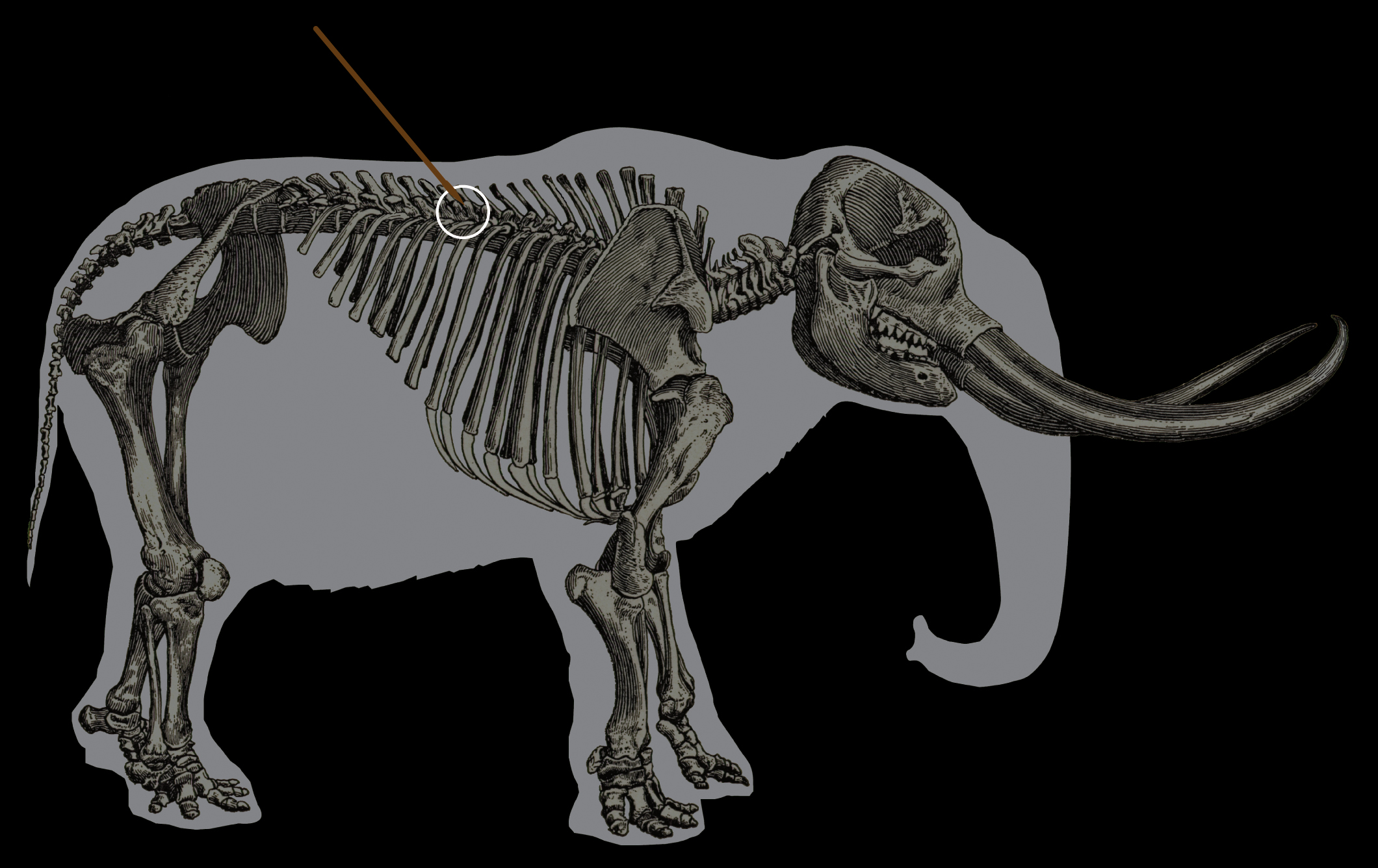 This is a mastodon skeleton and outline of a mastodon. The location of the rib and approximate angle of the spear is indicated. The point had to penetrate 25-30 cm of hide, tissue, and muscle. Image courtesy of Center for the Study of the First Americans, Texas A&M University
This is a mastodon skeleton and outline of a mastodon. The location of the rib and approximate angle of the spear is indicated. The point had to penetrate 25-30 cm of hide, tissue, and muscle. Image courtesy of Center for the Study of the First Americans, Texas A&M University
___________________________________
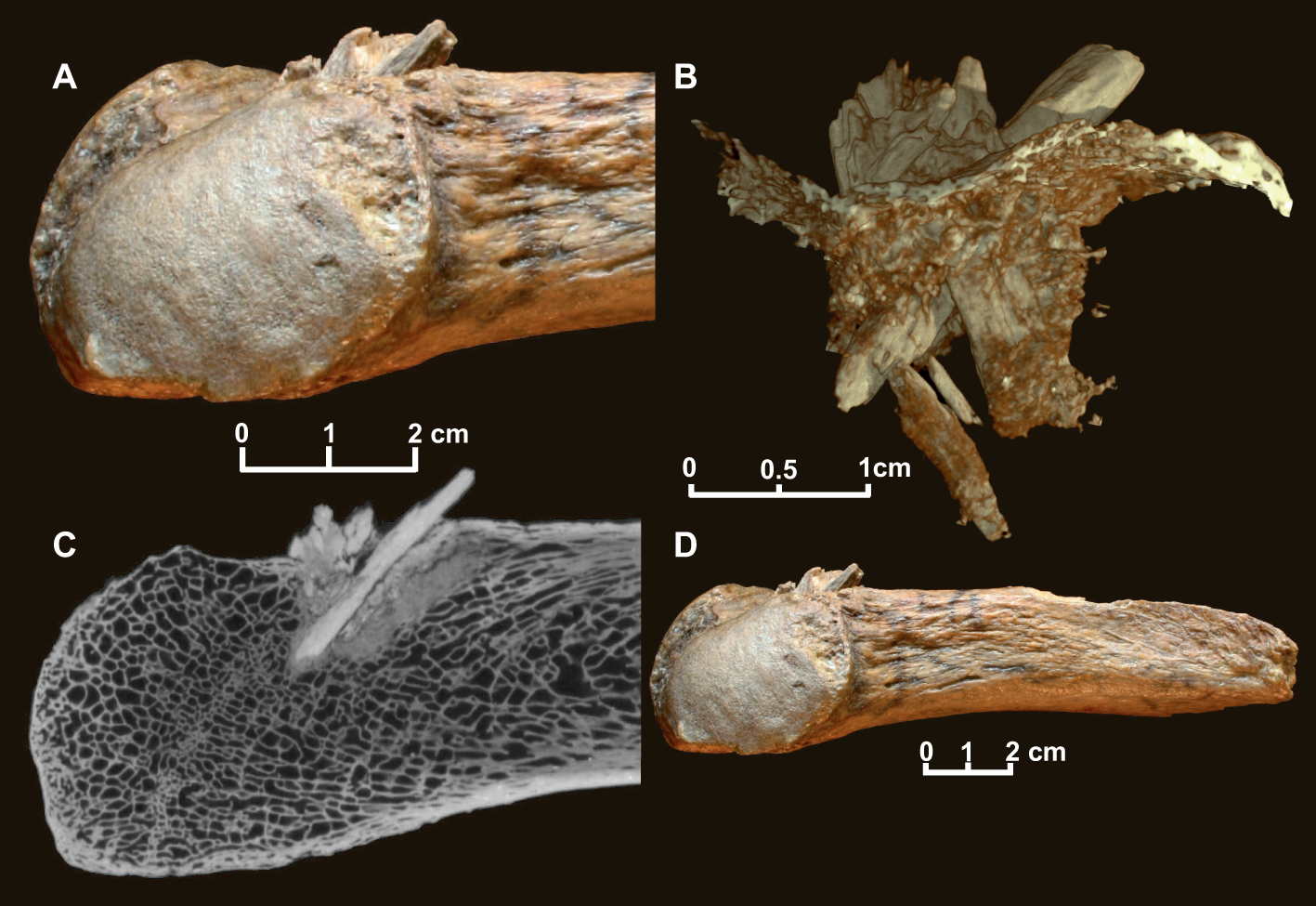
Mastodon rib with the embedded bone projectile point. (A) Closeup view. (B) Reconstruction showing the bone point with the broken tip. The thin layer represents the exterior of the rib. (C) CT x-ray showing the long shaft of the point from the exterior to the interior of the rib. (D) The entire rib fragment with the embedded bone projectile point. Image courtesy of Science/AAAS
__________________________________
But the archaeological finds are not the only body of evidence emerging in the changing picture related to who, when, and from where the first peopling of the Americas took place. New findings are developing with the application of genetic and paleoclimate studies….
Following the DNA Trail
In a study published in the American Journal of Human Genetics, Theodore Schurr, an associate professor in the University of Pennsylvania’s Department of Anthropology, in collaboration with a research team that included Ludmila Osipova of the Institute of Cytology and Genetics in Novosibirsk, Russia and others, analyzed the genetics of individuals living in Russia’s Altai Republic for markers in both mitochondrial DNA and Y chromosome DNA. Mitochondrial DNA traces the maternal, or female line of descent, whereas Y chromosome DNA traces the paternal, or male, descent. They compared the samples to those that had previously been collected from individuals in southern Siberia, East Asia, Central Asia, Mongolia, and a number of different Native American groups.
After analyzing the Y chromosome DNA, the researchers found a unique mutation common to both the Native Americans and southern Altaians in a lineage dubbed as “Q”. The Altai region is located at the four corners of what is today China, Russia, Mongolia, and Kazakhstan. Says Schurr, it “is a key area because it’s a place that people have been coming and going for thousands and thousands of years. Our goal in working in this area was to better define what those founding lineages or sister lineages are to Native American populations.”
They found similar results when analyzing the mitochondrial DNA. “We find forms of haplogroups C and D in southern Altaians and D in northern Altaians that look like some of the founder types that arose in North America, although the northern Altaians appeared more distantly related to Native Americans” says Schurr.
Determining how long ago the mutations took place, the researchers concluded that the southern Altaian lineage diverged genetically from the Native American lineage about 13,000 to 14,000 years ago. This correlates with current theories that support the migration of peoples into the Americas from Siberia between roughly 15,000 and 20,000 years ago.
The large and diverse nature of the database ensured a relatively high degree of confidence among the researchers about the validity and precision of the findings. Says Schurr, “at this level of resolution we can see the connections more clearly”.
Moreover, the completed research at the Paisley caves has also confirmed, through additional DNA testing, that the early occupants of the caves had ancestral Siberia-East Asian origins, and that they were using the caves as far back as at least 12,450 radiocarbon years ago (about 13,500 calendar years ago).
The results of another study (published in the July 11, 2012 issue of the journal Nature), while supporting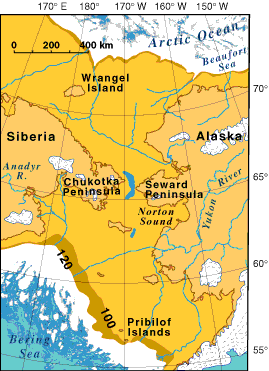 Schurr’s analysis and conclusions, paints a dramatically more complex picture of early American origins.
Schurr’s analysis and conclusions, paints a dramatically more complex picture of early American origins.
Led by Professor Andres Ruiz-Linares from the University College London (UCL) and Professor David Reich of the Harvard Medical School, an international team of researchers analyzed data samples from 52 Native American and 17 Siberian groups, examining more than 300,000 DNA sequences to examine patterns of genetic similarities and differences between the population groups. The study was complicated by the fact that the Americas experienced an influx of European and African immigrants since 1492, with 500 years of genetic mixing. To address this, the researchers developed a methodology to isolate genomes that were of entirely Native American origin. “We developed a method to peel back this mixture to learn about the relationships among Native Americans before Europeans and Africans arrived,” Reich said, “allowing us to study the history of many more Native American populations than we could have done otherwise.”
What they found was eye-opening.
“For years it has been contentious whether the settlement of the Americas occurred by means of a single or multiple migrations from Siberia,” said Ruiz-Linares. “But our research settles this debate: Native Americans do not stem from a single migration”.
Their results showed that Native American populations originally arose, not from one single migration of people, but at least three. The majority descended from a single original group of First American migrants, but at least two subsequent migrations also made important genetic contributions. Moreover, their origins could be genetically traced to populations traversing across the ancient Beringia land bridge (pictured above, right) that existed during the ice ages over 15,000 years ago. The second and third migrations left their imprint only in Arctic populations that speak Eskimo-Aleut languages and in the Canadian Chipewyan who speak a Na-Dene language. But even these people inherited most of their genetic makeup from the first migration. Eskimo-Aleut speakers, for example, derive more than 50% of their DNA from the first migrants, and the Chipewyan even more, about 90%. This suggests that the two later migrant groups mixed with descendants of the first migrants after they arrived in North America.
Said co-author Reich, “the Asian lineage leading to First Americans is the most anciently diverged, whereas the Asian lineages [the second and third migrations] that contributed some of the DNA to Eskimo–Aleut speakers and the Na-Dene-speaking Chipewyan from Canada are more closely related to present-day East Asian populations.”
What is more, said Ruiz-Linares, “our study also begins to cast light on patterns of human dispersal within the Americas”.
They found that people expanded southward along a route that hugged the coast. As they went southward, population groups split off along the way. After the splitting, there was little gene flow among Native American groups, especially in South America.
But the dynamics were not always this simple. They found, for example, that the first, Central American Chibchan-speakers have ancestry from both North and South America, suggesting a back-migration from South America, and that the Naukan and coastal Chukchi from north-eastern Siberia carry ‘First American’ DNA: the Eskimo-Aleut speakers migrated back to Asia, bringing with them the Native American genetic material.
Clues from a Past Climate
The broadly accepted view about when and how the first Americans entered the Americas has revolved in part around the changes in the glacial periods associated with the last glacial period of the Ice Age. Since about 40,000 B.P., the Cordilleran and Laurentide ice sheets covered much of Canada. However, during the warmer interglacial periods they retreated to create ice-free corridors along the Pacific coast and areas east of the Rocky Mountains of Canada. Scientists have long suggested that it was through these corridors that humans were likely able to cross Beringia into the Americas. Beringia was a land bridge as much as 1,000 miles wide that joined present-day Alaska and eastern Siberia at various times 110,000 to 10,000 years ago. Exactly when and how this crossing may have occurred has been a matter of debate for decades, but the most widely accepted proposal advances the suggestion that it occurred around 15,000 years ago.
A study published in the professional journal, Quaternary Science Reviews, resulted in findings that differ from this prevailing hypothesis by as much as 2,000 years. Led by Nicole Misarti of Oregon State University, the study, known as the Sanak Island Biocomplexity Project and funded by the National Science Foundation, was intended to examine the abundance of ancient salmon runs in the Beringia region. They analyzed core samples taken from Sanak Island, a remote island about 700 miles from Anchorage, Alaska, and about 40 miles from the coast of the western Alaska Peninsula. As the researchers began examining core samples from Sanak Island lakes looking for evidence of salmon remains, they came up with radiocarbon dates much earlier than they had expected. The dates were based on organic material in the sediments, composed of terrestrial plant macrofossils that indicated the region was actually ice-free earlier than believed. Deglaciation there from the last Ice Age, it seemed, took place as much as 1,500 to 2,000 years earlier. Moreover, the researchers had also concluded that the maximum thickness of the ice sheet in the Sanak Island region during the last glacial maximum was actually only 70 meters – or about half that previously projected. This suggested that deglaciation could have happened more rapidly than earlier models had predicted. Given the location, this opened the door for the possibility of earlier coastal migration models for the Americas.
“It is important to note that we did not find any archaeological evidence documenting earlier entrance into the continent,” said Misarti. “But we did collect cores from widespread places on the island and determined the lake’s age of origin based on 22 radiocarbon dates that clearly document that the retreat of the Alaska Peninsula Glacier Complex was earlier than previously thought. Glaciers would have retreated sufficiently so as to not hinder the movement of humans along the southern edge of the Bering land bridge as early as almost 17,000 years ago.”
This shed new light on a long-standing question. If humans had not arrived in the Americas until about 15,000 B.P. as traditional models had suggested, then how could they have spread so quickly to inhabit areas thousands of miles southward, as evidenced archaeologically by their presence at sites such as Monte Verde, Chile, and Huaca Prieta, showing remains dating back to 14,000 to 14,200 years ago? The answer, based on the Sanak Island findings, was that they had actually arrived in the Americas up to 2,000 years earlier.
Another finding was related to the presence of pollen in the samples.
“We found a full contingent of pollen that indicated dry tundra vegetation by 16,300 years ago,” Misarti said. “That would have been a viable landscape for people to survive on, or move through. It wasn’t just bare ice and rock.”
Moreover, she added, based on the findings in the tested area, “the region wasn’t one big glacial complex. The ice was thinner and the glaciers retreated earlier.” Furthermore, previous studies have indicated warmer sea surface temperatures possibly preceding the retreat of the Alaska Peninsula Glacier Complex (APGC), creating conditions more favorable to supporting productive coastal ecosystems that humans could have exploited.
Thus, if the researchers are right, the stage for human entry into the Americas had been set earlier than long theorized. As they wrote in the published study: “While not proving that first Americans migrated along this corridor, these latest data from Sanak Island show that human migration across this portion of the coastal landscape was unimpeded by the APGC after 17 (thousand years before present), with a viable terrestrial landscape in place by 16.3 (thousand years before present), well before the earliest accepted sites in the Americas were inhabited.”
The Emerging Picture
Taken together, new discoveries and research results are thus beginning to paint a picture of a human beginning in the Americas that is considerably more complex and likely earlier than previously thought.
That genetic studies have shown that a single original population of modern humans dispersed from southern Siberia toward the Bering Land Bridge, or ancient Beringia, as early as about 30,000 years ago, and further dispersed from Beringia to the Americas by perhaps 16,500 years ago. But there was more than one migration event, and some of them traversed from the Americas back into Asia. From the paleoclimate evidence, we see indications that the environmental stage was set by at least 16,300 years ago for an accommodating passage for humans into the Americas. From archaeology, we know that humans appeared south of the Canadian ice sheets by at least 15,000 years ago, 2,000 or more years before the emergence and spread of the Clovis culture, and it is no longer clear that there is a clear linear evolutionary relationship between the Clovis culture and early technology discovered in the western regions of the North American continent. Finally, from archaeology, evidence builds to support a suggested route along the deglaciated north Pacific coastline.
To be sure, new discoveries could significantly change or challenge this developing paradigm of the peopling of the American continents, but it could also continue to strengthen it. Time and continuing research will tell. Writes a researcher at the Center of the Study for First Americans at Texas A& M University: “This is an exciting time to be studying the peopling of the Americas. We are confident that through continued empirical research and active interdisciplinary dialog, we will soon know precisely when and how humans dispersed across the New World.”[1]
________________________
[1] The Story of the First Americans, The Center for the Study of the First Americans. http://csfa.tamu.edu/who.php
Article cover image, top left: Excavation team at work at the Friedkin site in 2016. Courtesy Michael R. Waters and Center for the Study of the First Americans, Texas A&M University
______________________________________
Meadowcroft
By Dan McLerran
Peering up at it from below, I could see that this wouldn’t be a leisurely stroll. This flight of seemingly countless steps, ascending with rails almost like scaffolding to a destination high above, invited a small sense of adventure. But I could envision that, long before this modern, convenient construction, human visitors surely had a more challenging task. I was told that casual visitors once had to ascend with the aid of a rope assemblage, and long before that, Native Americans had to reach it using whatever devices or efforts at their disposal. Carved by nature in a bluff overlooking a tributary of the Ohio River known as Cross Creek, the ancient rockshelter above had remained tucked away for millennia within a lush green, hilly landscape of what is today called the Allegheny Plateau of western Pennsylvania. Thousands of years of weathering and erosion made this place a cave-like shelter for prehistoric human sojourners—affording them protection from the elements without and a space to rest, sleep and eat within.
Once I reached the top of the steps, I could move freely over a spacious, human-made platform, designed to hold small capacity crowds. I could now see the interior of the rockshelter clearly laid out before me, left as it was after the latest archaeological excavations closed out (although the site continues to be investigated). But long before archaeologists and others came to investigate and work at the site, nature’s hand had already morphed its appearance many times over through thousands of years of weathering and erosion. I could see the visible reminders of this in the face of the sandstone cliffs surrounding it. Slowly sculpted by water, wind and ice, it was an almost surrealistic picture of what time and the elements could do to otherwise seemingly impermeable and impenetrable stone. Today, the rockshelter is enveloped in an impressive, protective overhanging wooden construction, an architectural wonder by itself.
Archaeologists, historians and the public call this place Meadowcroft. For those who know something about the site, the Meadowcroft rockshelter is now widely thought to have yielded evidence of the earliest known presence of humans in North America, along with the longest sequence of continuous human occupation. It was first systematically excavated by Dr. James M. Adovasio. His efforts included a team of colleagues and field school students in the early 1970’s. All together, they uncovered evidence of a human presence they suggested dated thousands of years before the time of the advent of the first broadly recognized human culture in the Americas—the Clovis—and its implied first peopling of the North American continent. Their dating at this site pushed the clock back on human occupation of North America to as much as at least 16,000 years ago.
But this stature and acceptance didn’t come quickly and easily for Meadowcroft and its chief archaeologist. It challenged the prevailing paradigm, radically pushing back the dates on human occupation of the continent. From the very beginning, the validity of his findings related to the earliest human modified stone objects and other features of human habitation found at the site were marked with controversy. Decades later, however, the story of the Meadowcroft controversy has evolved to one of broad acceptance. Partly due to the mounting evidence from other sites with Pre-Clovis artifacts across the Americas, and in no small measure to the meticulous and scientifically rigorous methods used in the Meadowcroft research, the site has arguably become a kingpin in a new mainstream of scientific inquiry that has increasingly legitimized the ‘Pre-Clovis’ way of thinking. Today, Meadowcroft is designated as a National Historic Landmark, drawing thousands of visitors yearly.
Popular Archaeology took the opportunity to interview Dr. Adovasio (pictured below, right) about the site and its significance within the context of the ongoing search and debate on the first peopling of the Americas. What follows are the details of that interview:
_______________________________________
 Q1: Would you describe your personal route/experience, attributes and interests that drove you to your current occupation or career?
Q1: Would you describe your personal route/experience, attributes and interests that drove you to your current occupation or career?
As I indicated in my book, “The First Americans,” I was essentially programmed to be an archaeologist by my mother, Lena M. Adovasio. She was a four-field major in college, one of which was history and another of which was chemistry. She taught me to read well before kindergarten with geology, paleontology, and archaeology books. As a consequence I never really wanted to do anything else except pursue an archaeology career. I knew where I wanted to go to undergraduate school in the 6th grade and, in fact, attended that institution (The University of Arizona). The attributes which I brought to the “archaeology table” were and remain, extreme attention to detail, a high degree of organization leavened with intense self-discipline, and, I suppose, the ability to absorb and synthesize oftentimes very diverse data sets. It probably helped that, like my mother, I was endowed with a near perfect memory.
Q2: What is the story of how Meadowcroft first came to your attention?
When I assumed a faculty position at The University of Pittsburgh in 1972, I was told that one of the parameters of that position was the establishment of an archaeological and geoaracheological field training program in western Pennsylvania. What I had hoped to locate was an area with little or no previous archaeological or geoarchaeological research coupled with relatively easy striking distance of Pittsburgh for obvious logistical reasons. I also sought an area which contained at least one cave or rockshelter site because these were the sites I was most familiar with from my graduate career at The University of Utah. Because I had previous research commitments on the Island of Cyprus in the eastern Mediterranean, I did not have the time to locate a suitable study area myself. So I circulated word amongst my colleagues in the profession, and as a result, a now deceased historian/amateur archaeologist from what was then California State College, California, Pennsylvania, informed me about Meadowcroft Rcokshelter in the early spring of 1973. His name was Phil Jack, a longtime friend of the landowner, Albert Miller, who discovered the site. I arranged with both of them to visit the site in the later spring of 1973 and upon viewing it decided to solicit permission from the landowners to begin excavations there in June of 1973. The rest is, literally, history.
Q3: While excavating at Meadowcroft in the 1970’s, what was it that made you realize that there was something special or unusual about this site?
We initially believed that the deposits at Meadowcroft would be something less than a meter in thickness and that the oldest occupation would be Late Archaic or Early Woodland, at best. These estimates were based on excavations at other rockshelters in southwestern Pennsylvania and adjacent portions of Ohio and West Virginia. However, early in the 1973 season it became clear that the deposits at the site were well in excess of a meter in thickness and the recovery of Middle and Early Archaic materials signaled an older occupation than we had imagined. Of course, when the first radiocarbon dates were run after the 1973 season was over, it was evident that the site was initially occupied earlier than we suspected.
___________________________________________
General view of Meadowcroft Rockshelter facing west before excavation in 1973; vegetation marks the limits of the vegetation current overhang; large block in lower left represents a roof detachment ca. 12,500 years ago. Image courtesy James M. Adovasio
____________________________________________
Q4: What finds convinced you that you had uncovered evidence of human occupation at this site going back possibly 16,000 years or more?
The answer to this question is more complicated than it seems. The deposits at Meadowcroft are characterized by a series of roof spalling and block collapse events which dramatically altered both the configuration of the rockshelter, as well as the availability of “livable” floor space through time. One such spalling event marks, in effect, the Pleistocene-Holocene boundary as well as, for all intents and purposes, the end of the Clovis interval in southwestern Pennsylvania. Beneath this spalling event, we expected to encounter no additional, older cultural material, but rather the parent bedrock of the rockshelter in the form of the Birmingham Shale. Instead of the Birmingham Shale, we found a series of apparent occupational surfaces replete with shallow fire pits and associated artifacts of indisputable anthropogenic origin. Radiocarbon dates derived from charcoal within these pits clearly preceded the established age of Clovis in eastern North America, thereby, and surprisingly to us, indicating an earlier than Clovis occupation. Additionally, none of the recovered artifacts, most notably the unfluted lanceolate so-called Miller projectile point [named after the site’s discoverer] and small blade flakes, were consistent with a Clovis ascription.
_______________________________________
Lithic shown under rockfall is the type specimen of the Miller Lanceolate projectile point form. Courtesy James M. Adovasio
______________________________
Miller Lanceolate projectile point type specimen, obverse surface; the specimen is significantly re-sharpened and reduced in overall dimensions from the hypothesized prototype; it is unfluted, but basically ground. Courtesy James M. Adovasio
_________________________________
Assorted Miller Complex artifacts from Stratum IIa (containing the oldest cultural remains radiocarbon dated to about 16,000 years B.P.) at Meadowcroft Rockshelter; from left to right: Miller Lanceolate type specimen made of local Cross Creek chert, prismatic blade flake made from Onandaga chert, prismatic blade flake made from Flint Ridge chert, biface fragments made from Flint Ridge or Kanawha chert (black specimens are Kanawha). Courtesy James M. Adovasio
______________________________________________________
Q5: What is the significance of these findings within the context of the Clovis First debate?
Meadowcroft was the first site in nearly 40 years to seriously challenge the long held Clovis-First paradigm. Between 1933 and 1973, more than 500 archaeological sites in North and South America were claimed to be older than the Clovis horizon of ca. 10,900 to 11,300 uncorrected radiocarbon years ago. Prior to Meadowcroft, all of these Pre-Clovis claimants exhibited a similar history. First, you would read about them in a local newspaper or popular scientific journal, then more extensive treatments would appear in the technical scientific literature. Inevitably, the sites would then be exposed for some real or imagined flaw – the artifacts were not definitively of human origin; the stratigraphy was non-existent or imperfectly defined; the context and association of even genuine recovered artifactual material was problematic, etc. As I pointed out in “The First Americans,” each of these sites enjoyed a Warholesque 15 minutes of fame, then disappeared into oblivion. Each time one of these claimant sites failed, it reinforced the Clovis-First model. Therefore, by the time the initial reports on Meadowcroft appeared, there was a long established record of failure which served to render the Meadowcroft discoveries suspect ab initio.
Q6: Do you think the Clovis First paradigm is now discredited, or on its way out, given the findings from other sites across the Americas that show evidence of human occupation before Clovis times? (In other words, do you think there is sufficient evidence now to support a pre-Clovis presence or culture in the Americas, and why?)
To answer this question, it is perhaps useful to cite an observation by Dr. Jonathan C. Lothrop in his review of a Pre-Clovis site in the Americas, a volume published by the Smithsonian Institution. He says,
“In 2015, if one polled New World archaeologists familiar with the literature, I suspect most would agree that there is a growing body of evidence of human occupation in the Americas that pre-dates ca. 13,200 Cal. B.P.” (Lothrop 2015: p. 256)
I certainly concur with Lothrop’s assessment, but it is also worth stressing that a handful of very vocal, Clovis-Firsters still remain and, like Hrdlicka in an earlier time, will probably go to their graves with their minds unchanged. The death of established paradigms often takes a very long time—as witnessed, for example, by the many decades which elapsed between the promulgation of continental drift and its widespread acceptance in the geological community. I completely underestimated how long it would take for Clovis-First to expire and I also misjudged the degree to which its “spear carriers” would hold on to their beliefs. This is all particularly interesting given the fact that, almost from its inception, most European scholars and virtually all South American scholars questioned the underpinnings of the Clovis-First model. The American response, of course, was that the Europeans were simply ignorant of the facts and that the South Americans didn’t even publish in English. The number and distribution of what might be called broadly acceptable Pre-Clovis archaeological sites now clearly points to an earlier than Clovis presence. I stress, however, that even if there were only one, then one would be sufficient. Monte Verde effectively terminated the argument even if its still vocal critics don’t accept the fact.
_____________________________________________
Blade flakes from Stratum IIa at Meadowcroft Rockshelter; cross sections range from prismatic on the first three specimens to triangular on the forth; the edge is intentionally dulled for hafting. Courtesy Jame M. Adovasio
________________________________
Bifaces from Stratum IIa at Meadowcroft Rockshelter. Courtesy James M. Adovasio
________________________________________________________
Close up of blade flakes from Meadowcroft Rockshelter; one edge of each blade flake is intentionally dulled for hafting, while the opposite edge is the working edge. Courtesy James M. Adovasio
___________________________________
Polyhedral blade cores of the type from which Meadowcroft blade flakes were struck; these are very different from Clovis blade cores. Courtesy James M. Adovasio
_____________________________________________________
Fractured punch made of antler and truncated blade flake lying upon a 13,500 year old surface. Courtesy James M. Adovasio
_________________________________
Q7: What were the specific challenges of excavating and investigating the site?
All cave and rockshelter sites around the world are part of what some archaeologists call the “marked landscape”. Places so designated were well known to aboriginal populations both in time and through time and as such, were frequently visited and utilized. While some of these sites probably witnessed yearly visits, many were only episodically visited. Because of repetitive visits, often over very long periods of time, such sites provide the opportunity for studying environmental change and concomitant human adjustments to those changes in very unique ways. Unfortunately, depending on the nature, intensity, and duration of these visits, these types of sites may evidence considerable anthropogenic disturbance with attendant difficulties in establishing the stratigraphic/occupational sequence. Additionally, because of the nature of the depositional process in many of these sites, even without human disturbance, the stratification may be remarkably complex. The combination of naturally complicated stratigraphy and repetitive human visits with attendant disturbance render the proper excavation of these kinds of sites very difficult.
Q8: What specific techniques, processes, methodologies and applications made the investigation of this site stand out from other excavations or investigations?
A necessary preamble to this answer is to state that a field archaeologist in virtually any setting – prehistoric, historic, or forensic – has three basic responsibilities. The first, and most fundamental of these, is the reconstruction of stratigraphy from visible stratification. While in English, we tend to use the terms “stratigraphy’ and “stratification” interchangeably, they do not, in fact, mean the same thing. Stratification is an objective phenomenon. It has both subjective and objective physical properties which can be detected, assessed, and measured. Stratification is a product. Stratigraphy is both the process by which stratification is created and the study of that process. The establishment of stratigraphy from observable stratification is fundamental and critical to the other two responsibilities of a field archaeologist. Without it, the other two cannot be done. The second responsibility is the delineation of context. Context literally means place in time and space and unless the context of all recovered material is explicitly defined in a stratigraphic perspective, there is no context. Finally, perhaps the most difficult field responsibility is the demonstration of association. Association means that two or more items have entered the archaeological record penecontemporaneously as a consequence of the same process. Association refers, in forensic terms, to primary or probative evidence as opposed to secondary or circumstantial evidence.
Suffice to note, for reasons already articulated, it is particularly and peculiarly difficult to execute the three responsibilities of a field archaeologist in a cave or rockshelter situation. To execute these responsibilities in any excavation situation requires knowledge of and the ability to operationalize all of the so-called laws of stratigraphy. While most people are familiar with the first of these laws – superposition – many are, to varying degrees, unfamiliar with the remainder. These include original horizontality, lateral continuity, and intersecting relationships. The key to operationalizing all of these principles – frequently referred to as Steno’s Laws – requires the ability to recognize and delineate the contacts or interfaces between discrete strata. Without digressing into an arcane lecture on methodology, it should be noted that during the Meadowcroft excavations much of our attention was directed precisely at facilitating and defining interfaces and contacts. Students were exhaustively trained to recognize strata differences on the basis of perceived textural differences. In practice, this meant that they could use their trowels to detect differences in compactness versus friability, density versus porosity, and related properties by feel and even sound. Once sufficiently skilled, our students could recognize stratigraphic differences quite literally with their eyes shut in much the same way that anyone could detect by feel and sound alone the difference between layers of cake and icing between those layers. Despite the reliance on texture in the excavation training process, a wide array of other things were done to maximize the ability to “see” stratigraphic transformations in profile. Meadowcroft, virtually from the outset, was fully electrified and thanks to University of Pittsburgh engineers in conjunction with assistance from Westinghouse, we were able to install an experimental lighting system that allowed the excavators to combine different light sources to illuminate stratigraphic profiles in a variety of ways. The difference between different light source combinations was and is striking and, at that time, had not been employed extensively as a supplement to excavation.
In order to systematically plot the three-dimensional Cartesian coordinates of artifacts and ecofacts, a series of vertical and horizontal datum points were combined, initially manually, and later, via total stations, to ensure the establishment of the appropriate provenience or context of excavated materials. Since the rockshelter had an active phone line, we could then communicate directly via telephone modem to the mainframe at the University of Pittsburgh to encode excavation data. To my knowledge, this is also the first time that was ever done – at least in a cave or rockshelter setting.
In order to provide objective verification of what were subjectively defined strata, samples of sediment from each stratum or microstratum were processed with a Coulter blood cell counter converted to measure sediment size differences. Once again, this was the first time such technology had been employed in the field.
I could continue in this vein, but the point here is simply this – given the experience and imagination of the investigators, coupled with sufficient funding, we were able to implement a variety of data recovery and documentation as well as analytical protocols which had never been extensively employed before. While some of these did not work as expected, many did. The collective effect was a level of precision in the excavations which virtually no critic of the site has ever questioned.
______________________________________________
Precision and care: Excavation of a thin anthropogenic surface at the site via single-edged razorblade. Courtesy James M. Adovasio
_________________________________
Above and below: On-site documentation procedures at Meadowcroft Rockshelter; colored pencils which represented different combinations of silt, sand, and clay-sized materials were employed to produce microstratigraphic profile maps of all parts of the excavation. Courtesy James M. Adovasio
_________________________________
Q9: What arguments or issues did you have to address regarding the validity of the finds and their dating?
Virtually from the publication of the first radiocarbon chronology from Meadowcroft in 1974, the possible age of the earliest occupation of the site engendered great controversy. Significantly, especially as compared to other putative Pre-Clovis claimant localities, none of this controversy surrounded either the excavation methodology employed at the site nor the possible anthropogenic origin of any of the earliest artifacts. As already noted, the excavations at Meadowcroft were, and still are, widely hailed as “meticulous” and the “early” artifacts bear the unmistakable stigmata of humanly modified materials. Instead, the criticisms of the possible antiquity of the site pivoted around three basic issues: 1) the possible particulate or non-particulate contamination of only the eleven oldest radiocarbon samples from the site; 2) the absence of Pleistocene faunal remains; and 3) the apparently anomalous character of the recovered floral materials.
Dozens of pages of published material have been devoted to refuting the objections to the apparent age of the lower and middle Stratum IIa materials from Meadowcroft and these arguments will not be repeated here. It should be sufficient to note that there is absolutely no probative evidence for the particulate contamination of any of the eleven oldest C-14 samples from Meadowcroft. As to non-particulate contamination, the introduction of dissolved older carbon into just the eleven deepest radiocarbon samples from Meadowcroft requires a vehicle for contamination in the form of groundwater movement. An intensive micromorphological study conclusively demonstrated that such movement did not occur and, therefore, the non-particulate contamination issue is moot.
As to the faunal and floral critiques, modern research indicates that the paleoenvironment south of the glacial ice front in North America was remarkably variable and diverse. Further, the floral species represented at Meadowcroft were not inconsistent with such diversity. Finally, the faunal remains from Meadowcroft’s oldest deposits are diminutive both in numbers and weight, though all of the species represented have been reported in Late Pleistocene contexts elsewhere in eastern North America.
Put most simply, all of the currently available data suggests that Meadowcroft was sequentially and sporadically visited before the advent and spread of Clovis technology by populations who may or may not have been the ancestors to the makers of fluted points.
Of course, a larger issue, at least for some scholars, was the absence for a period of time of “other Meadowcrofts.” Now, of course, there are other sites of demonstrable Pre-Clovis age. Despite the best efforts of diehard Clovis-Firsters to discredit these other localities, often with incredibly convoluted and far-fetched scenarios, the existence of Pre-Clovis populations in the new world is now widely accepted.
Meadowcroft set the evidentiary bar! Monte Verde broke it! Other sites are appearing to join them. For Clovis-First it is the end of the game.
Q10: If you were to create a scenario or story describing the nature and lifestyle of the early, Pre-Clovis inhabitants of the site, what would it be?
As described in various publications, the earliest visitors to Meadowcroft appear to have been broad spectrum foragers rather than megafauna-focused big game hunters. These populations visited the site, as would their successors, principally in the fall of the year, utilizing a durable technology that included the production of unfluted lanceolate projectile points and the manufacture of diminutive blade flakes from polyhedral cores. They also employed a perishable technology that included basketry and presumably a variety of other less well documented related technologies. Their visits to Meadowcroft were apparently brief and perhaps separated by a number of years. They exploited a wide array of lithic raw material sources which I personally do not believe reflect their range. I would suspect these materials were acquired by trade and exchange. These sources include Kanawha chert from West Virginia, Onandaga chert from New York, and Flint Ridge chert from Ohio to name but a few. Evidence of these earliest visitors to Meadowcroft, named by us the Miller Complex after Albert Miller who discovered the site, are also evidenced at several other localities in the Cross Creek Drainage and a very similar durable technology is also evident at more remote locations like Cactus Hill in Virginia. While there are no obvious technological connections between Miller durable technology and Clovis, there is the possibility that some sort of relationship may be discovered in the future.
_____________________________________________
Reenactment of Paleoindian family unit showing both genders, different ages, durable and non-durable technology. Courtesy James M. Adovasio
_____________________________
Q11: What is in store for the future investigation and research of this site?
About one third of Meadowcroft remains unexcavated. This area is available for future study when there are even more resolute excavation, documentation, and analysis protocols available. The main task at present is to complete the long overdue final report as well as a series of smaller contributions about one or another aspect of the long Meadowcroft sequence.
Q12: Are there any other comments you would like to make?
The Meadowcroft/Cross Creek operation was originally designed as an undergraduate and graduate training project aimed at both anthropology/archaeology students and those in related fields. Obviously, there was also a research component but this was, at least on paper, secondary to the student training goal. Because of the experience of the multidisciplinary research staff as well as access to extraordinary funding, it was possible to not only offer students state-of-the-art protocols in site excavation, documentation, and analysis, but also to constantly refine those protocols from both a methodological and substantive perspective. Because of the foregoing, the excavations at Meadowcroft were considered by others to be at the very cutting edge of the field. That they are still considered by many to be so is a testimony to the success of the methodological aspect of the project. We have always been more proud and pleased with the methodological “end” of the Meadowcroft project than any, or even all, of the results it produced. Expanding the envelope of the field in any perspective is rewarding, but in terms of actual enhancement of field data collecting procedures, it is and has been particularly gratifying. From a more substantive perspective, while the earliest materials from Meadocroft have garnered the most attention, the incredible length of the occupational sequence is to us far more striking. Because of the lengthy and hyper-detailed Paleo-environmental record from Meadowcroft, we can examine macro and micro climatic changes and their attendant consequences very precisely. We can also articulate in unique ways human responses and adjustments to those changes. That was in essence the “cake” we were trying to bake. That the site proved to be quite old was the unintended “icing.”
For more information about the Meadowcroft Rockshelter and other related attractions at the site, see the website, Meadowcroft Rockshelter and Historic Village.
____________________________________________
The Pre-Clovis Site of Page-Ladson
By Michael Gordon
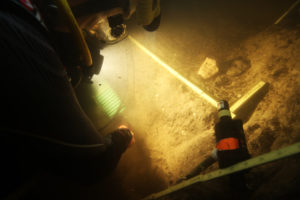
Underwater excavations at the 14,600-year-old Page-Ladson site. Center for the Study of the First Americans, Texas A&M University
_________________________
As it traverses the marshy Gulf coast lowlands of the Florida panhandle’s Big Bend region, the aquifer-fed Aucilla River would not fit the typical description of a North American river. It flows visibly above the surface in places, like most rivers do, but then disappears in other places into an ancient underground sinkhole system, carved into a vast limestone bedrock foundation over time by geological processes of erosion and collapse. Many thousands of years ago, one might not have recognized it as a river at all. Back then, when sea level was much lower, it was simply a series of sinkholes of various sizes, clearly visible from the surface. Today, the river is an underwater treasure trove of fossilized remains of long-extinct creatures. Needless to say, it has been an important paleontological destination for scientists conducting research on the North American Pleistocene past.
One place along the river, known as the Page-Ladson site, has recently yielded some tantalizing finds — evidence of a very ancient human presence, people who lived here before the Clovis era more than 14,000 years ago.
But few people can actually see this site. It lies submerged under about 30 feet of water and additional layers of sediment within a bedrock limestone sinkhole 60 meters in diameter. It is the exclusive domain of scuba divers. Everyone else, at the surface, only sees the slow-moving river flowing through a thick cypress swampland. During Pleistocene times, however, this sinkhole was essentially dry and easily accessible, and for the animals of the time, it had a particularly attractive feature — a small freshwater pond at its base. We know this because, since the mid-1980’s, scientists have studied the geology and recovered bones and other evidence there that tell a story of giant Ice Age mammals frequenting the pond for its fresh water.
Digging Page-Ladson
It was in the early 1980’s when Buddy Page, a recreational diver and avocational archaeologist, recovered elephant bones beneath the surface of what is today known as the Half-Mile Run section of the Aucilla River. Thinking that any further investigation would require the services of a professional team of scientists, he reported the site and his finds to Jim Dunbar, then of the Florida Bureau of Archaeological Research, and David Webb, professor of Vertebrate Paleontology at the University of Florida. Together with a team of divers and other experts, Dunbar and Webb proceeded to excavate and study the site beginning in 1983, discovering in the process eight stone artifacts, mostly flakes, in association with butchered mastodon bones within a deposit dated through radiocarbon dating techniques to more than 14,400 years old. Most remarkable was an adult mastodon tusk that exhibited what appeared to be human-made cut-marks.
The findings were not without controversy. The age of the finds based on the dated deposit “was an impossible age for the scientific community to accept at the time,” says Jessi Halligan of Florida State University, a co-author of the most recent study and report on the Page-Ladson site, “because it was well-accepted that the Americas were colonized by the Clovis people who arrived on the continent over the Bering Land Bridge no more than 13,500 years ago at the oldest.”
Part of the difficulty surrounded the nature and difficulty of the location. “As an underwater site, it could not be visited by just any member of the archaeological community, so the discoveries could not be verified by impartial peers,” says Halligan. “And everyone knows that rivers are destructive earth-movers, so it seemed quite possible that even if the layers were as old as the researchers reported, that the material may not be cultural at all.”
Dunbar and Webb published their research on the findings, but for years their findings, enshrouded in dispute, were consigned to near oblivion.
Until 2012.
Texas A&M University’s Center for the Study of the First Americans decided to take on the challenge by returning to Page-Ladson to finally resolve the status of the site. “I always thought the site had great potential to help us resolve the issue of whether people were here before Clovis and I always wanted to investigate the site,” said archaeologist Michael Waters, Director of the Center. “I got my chance in 2012 when John Ladson [the owner of the property surrounding the site] invited me to investigate the site.”
Waters, long a well-known name in First American studies, turned to Jessi Halligan to join him as co-director of the new project. Halligan, a veteran of 20 years in North American archaeology and who studied under Waters at Texas A&M, had already been deeply involved in Aucilla River research since 2007. Together, they headed a group composed of scientists and divers that would lend the best expertise to the total research effort. It was a perfect team.
But the challenges were considerable. First of all, the site was 30 feet underwater, requiring SCUBA access. Communications between divers during any excavation thus meant using hand signals and notes written on mylar clipboards. Because the river water was stained into a dark red color by tannins, most sunlight could not penetrate the depths to the site, so lights were needed to work. Safety was a premium, so work demanded extensive logistics which required diving in teams of two, redundant SCUBA equipment, a dredge and dredge operator for the dive teams, and additional divers at the surface to manage the divers and air supply. All materials recovered and brought to the surface had to be meticulously dried and conserved, a time-consuming process.
Added to this were the environmental and weather conditions. “We were hot, dirty, and bitten by bugs,” said Waters. “The first year we worked at the site, we were plagued by flooding and hurricanes.”
Reaching their goal of finding new evidence of pre-Clovis occupation proved elusive at first. “The area we excavated yielded no artifacts,” wrote Waters to Popular Archaeology. “We confirmed the stratigraphy and found some bones of extinct animals, but we needed artifacts.”
But for Waters and Halligan, persistence was the name of the game. “We were convinced we needed to give it another try and the next season we had better weather,” said Waters.
Along with the better weather came better results. In 2013, Waters and Halligan hit their ‘pay dirt’. There were multiple dives, but on one dive, a crew that included Morgan Smith, a graduate student of Waters, and John Albertson, went down to clean up an excavation unit and began to excavate a new level. As they dug, Albertson’s trowel met some resistance. Fanning the sediments away, he found what appeared to be an artifact — a biface. Leaving it in place, Smith came up to the surface to announce the new discovery.
“We decided to collect samples from all around the biface and above it and below it for radiocarbon dating so that there would be no confusion about its age,” said Waters. “In the end, 71 samples were radiocarbon dated and confirmed the age of the artifact to 14,550 years ago.”
Finally bringing the artifact up to the surface after the dating samples were taken, they determined upon examination that it was indeed a biface — a reworked knife fragment — lying in the same deposit that contained the remains of extinct mammals — mastodons, camels and bison. This was the same deposit in which Dunbar and Webb had discovered the mastodon tusk that featured cut-marks — the multiple, parallel, deep linear grooves that ran perpendicular to the long axis of the tusk — clear signs of human activity. Other flakes were found within the same or similar deposits, bringing the total artifact finds to six.
“We were all excited,” Waters wrote Popular Archaeology. “I will never forget that day and the feeling of excitement when the artifact came to the surface. It was like a moment when you know you have found something special that will change a long held paradigm.”
Waters was right. It was a moment, like some other moments at other sites, that would change what we know about when and how the first Americans made their debut in the Americas.
_________________________________________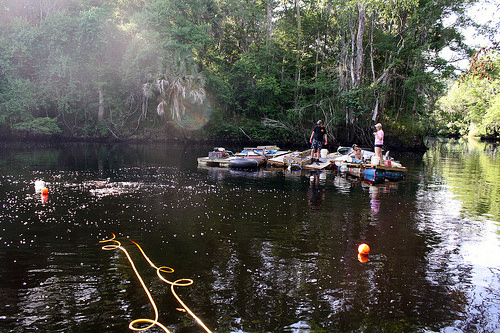
Surface setup at the site, showing the floating screen decks with yellow hoses leading to divers underwater, bubbles by buoys are air bubbles from divers. Pictured are John Albertson, Rodrigo Torres, and Jessi Halligan on floating screen decks. Photo by Adam Burke. Provided courtesy of the Center for the Study of the First Americans (CSFA).
_______________________________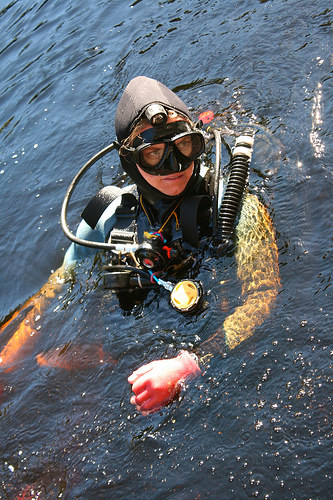
Halligan waiting to begin a dive. Photo by Brendan Fenerty. Provided courtesy of the Center for the Study of the First Americans (CSFA).
______________________________________________________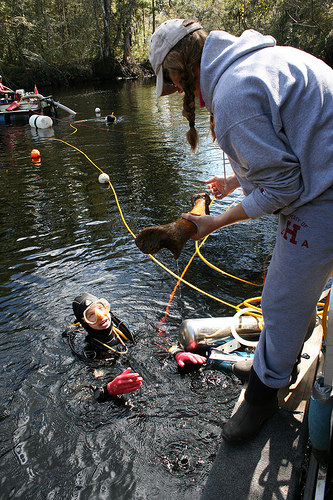
Halligan and Neil Puckett examining find. This is a juvenile mastodon radius. Photo by Brendan Fenerty. Provided courtesy of the Center for the Study of the First Americans (CSFA).
________________________________________
Puckett bringing subadult mastodon bone to surface for conservation. Photo by Brendan Fenerty. Provided courtesy of the Center for the Study of the First Americans (CSFA).
_______________________________________
Halligan excavating underwater during 2015 season. Photo by Shawn Joy. Provided courtesy of the Center for the Study of the First Americans (CSFA).
_________________________________________________________
The pre-Clovis biface in place at the bottom of the 2013 excavation block just after discovery. Photos by Jessi Halligan. Provided courtesy of the Center for the Study of the First Americans (CSFA).
___________________________________________________________
Excavation Schematic Image by Jessi Halligan. Provided courtesy of the Center for the Study of the First Americans (CSFA).
________________________________________________
Morgan Smith and Michael R. Waters examining biface immediately after its discovery (by Smith and his dive buddy, John Albertson). Photo by Adam Burke. Provided courtesy of the Center for the Study of the First Americans (CSFA).
_____________________________________________
Tusk reassembled. Adult mastodon tusk from ARPP excavations at the Page-Ladson site (UF 150701) shown reassembled for Dr. Daniel Fisher’s reexamination of the cut-marks. Jessi Halligan, Cindy Fisher, and FLMNH researcher Jason Bourque shown. Photo by Daniel Fisher.
__________________________________________
Making the Case
“The Gold Standard necessary to demonstrate unequivocally that a site pre-dates Clovis has always been 1) clear evidence of human activity usually in the form of stone tools; 2) artifacts occurring in a solid geologic context, and 3) artifacts dated using a reliable dating technique,” asserts Waters. Page-Ladson, they maintain, meets all of these criteria for several reasons:
- At Page-Ladson, unequivocal lithic artifacts, including a bifacial knife and utilized flakes, are associated with mastodon remains (including a tusk with stone tool marks).
- These artifacts are sealed in undisturbed geological deposits at the base of a 4-m-thick stratified sequence.
- Seventy-one new radiocarbon ages show that the artifacts date to 14,550 years ago and that the stratigraphy at the site is undisturbed.*
Armed with this evidence, Waters and Halligan suggest that the site plays a significant role in informing the ongoing debate about how and when the first peoples of the Americas settled the landscape and what they were doing. They point to the research showing that Page-Ladson is about the same age as the Monte Verde site, indicating that people were living on both American continents at least 14,500 years ago; that there were also people, based on archaeological finds, present at this time in Washington, Oregon, Texas, Wisconsin, and Pennsylvania; that the findings are consistent with the genetic research showing a pre-Clovis presence in the Americas; and that evidence in the form of dung fungus at Page-Ladson indicates that large mammals like mastodons became extinct around 12,600 years ago, showing an overlap of humans and a large extinct mammal presence, suggesting the possibility that human hunting may have had an impact on their extinction.
Most significantly, the Page-Ladson finds feed into an emerging new paradigm. “At the time people were butchering or scavenging a mastodon carcass at 14,550 years ago at Page-Ladson, the Ice Free Corridor or inland route into the Americas would have been closed,” Waters concludes. “The evidence from Page-Ladson provides indirect support for a coastal migration into the Americas. How people made their way to Florida and how long this took, we can only speculate, but this [obviously] hints at an even earlier arrival of people into the Americas.”
Popular Archaeology asked Halligan if she, based on the findings, could reconstruct the scene that existed at this place so long ago in prehistory:
What we have evidence for is the following: 14,500 years ago, people were within this steep-walled sinkhole butchering a mastodon at the edge (and possibly partially within) a shallow pond. They expended a great deal of effort to extract a tusk that they later left behind, either because they were only interested in the fatty meat within the tusk cavity, or because they wanted to leave it preserved in the shallow pond for later, but never returned for it. The evidence from this site is sparse, but its location and contents can tell us some important things: this site shows people were well-familiar with the landscape, and knew where to get stone for toolmaking, knew how to extract a tusk, and knew when, where, and how to access freshwater. In other words, they were very capable and competent hunter-gatherers who probably were pretty familiar with this landscape.
Looking Ahead
For now, neither Waters nor Halligan have any immediate plans to return to the field at Page-Ladson. It doesn’t mean, however, that work is over. Project staff is busy documenting the findings from the younger strata at the site, including pollen and spore analysis and special studies on core and sediment samples, and Waters and Halligan are also continuing their search for other sites that may bear on the earliest Americans.
In the end, whether or not scientists return to Page-Ladson for further excavation and survey, the site is already well on its way to leaving a legacy.
“The record of human habitation in the Americas between 14,000 and 15,000 years ago is sparse, but it is real,” concludes Waters. “The few stone tools and the other evidence left behind by hunter-gatherers at the bottom of the Page-Ladson sinkhole 14,550 years ago will have a long lasting and profound impact on our understanding of the earliest pioneers and explorers of the Americas.”
___________________________________________________
Diving crew lined up for survey work. These divers are waiting to conduct a survey, looking for new sites. Photo by Jessi Halligan. Provided courtesy of the Center for the Study of the First Americans (CSFA).
________________________________
*Michael Waters, response to Popular Archaeology inquiry, January 2017.
Information for this article was obtained from a variety of sources, including written interviews with Michael Waters and Jessi Halligan, as well as the detailed study report cited below.
Halligan et al., Pre-Clovis occupation 14,550 years ago at the Page-Ladson site, Florida, and the peopling of the Americas, Science Advances 13 May 2016;2:e1600375
Cover image, top: SCUBA diver Ivy Owens collecting micromorphology samples during 2015 season. Photo by Shawn Joy. Provided courtesy of the Center for the Study of the First Americans (CSFA).
________________________________
West Coast Rising: Huaca Prieta
By James Kensington
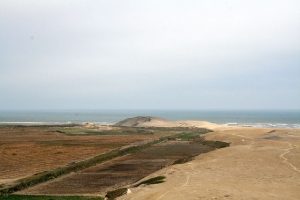
View of the Huaca Prieta site on the coast of Peru. Courtesy Tom Dillehay
___________________________
Just north of the bustling city of Trujillo, a distinctively imposing 30-meter-high mound of earth and stone overlooks the Pacific coast along the edge of the Chicama Valley. Unlike Trujillo, it is a quiet place. Agricultural fields dress its backdrop nearby. It has a name — Huaca Prieta, which, in Spanish, means “dark mound”. To the casual passer-by it strikes the impressive image of a distinctive greyish natural hill rising prominently behind the beach. But aside from its imposing physical appearance, Huaca Prieta stands apart for another very dramatic reason: within the underlying terrace that defines its foundation lies an archaeological record of human occupation that goes back as long ago as nearly 15,000 years B.P., with the astounding discovery of this very early occupation only recently coming to light.
________________________________________
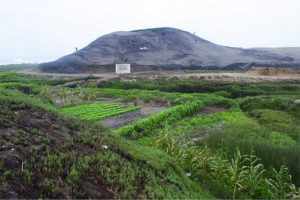
Huaca Prieta means “dark mound”, which was built on a low late Pleistocene terrace between 7,800-3,500 years ago and since then used as a burial place for later cultures. Today it is used for shaman rituals. Buried in the terrace below the mound are maritime and terrestrial cultural remains dated from about 14,500 to 8,000 years ago. Courtesy Tom Dillehay
____________________________________________________
The Huaca Prieta Story
Archaeologists first began uncovering the mystery of the mound when excavations began under Junius B. Bird in 1946–1947. He and his team excavated three test pits. Among their finds were complex textiles with designs representing mythological humans, snakes, crabs and condors, as well as stone artifacts such as pebble tools and flakes. While excavating, they encountered the remains of underground structures, some of them featuring burials constructed of cobblestones and an ash-water mix. Evidence also emerged, with objects such as fish net weights and fish bones, that suggested the ancient inhabitants were fishers and gathered shellfish, with organic remains also indicating they were agriculturalists, growing beans, squash, gourds, tubers, peppers, cotton and fruit.
But the latest, and perhaps most remarkable, chapter at Huaca Prieta did not unfold until 2006, when anthropologist Tom Dillehay of Vanderbilt University began excavations and investigations of the site with the late Peruvian archaeologist, Duccio Bonavia, and a multi-disciplinary team of scientists and specialists. (Dillehay is best known for his work and discoveries at Monte Verde in Chile, where evidence of early human settlement more than 14,000 years old was found in 1975, challenging the long-held Clovis theory that suggested the first human arrival in the Americas was no older than 13,000 years ago). “I was always fascinated by the work of Junius Bird at the site and by the incredibly distinct color and form of the mound located next to the ocean,” said Dillehay of the site. “I had never seen anything like it.” Dillehay had been working on the north coast of Peru since 1976 and continued to visit the site, but a series of unanswered questions, and a tip from geologists who had previously examined the site suggesting it could possibly contain cultural material deep into prehistory, inspired him to renew investigations.
As a scientist, however, Dillehay’s interest went far beyond the prospect of discovering deep history. “The objectives were simply to better understand the economy, stratigraphy and chronology of the site with new questions and methods,” he continued. “We also planned a detailed interdisciplinary study focused on paleoecology and outlying settlement patterns in the area, including other Preceramic sites, and we wanted to produce detailed quantification and qualification of the faunal and floral remains.”
His investigations slowly made their way to accomplishing these goals. But little did he know what treasures awaited him and his team as they carefully and systematically dug their way down through the mound. “We had expected many of the findings, but we found many more and diverse items than Bird had found,” said Dillehay. The team uncovered exotic materials, as well as food and non-food remains, and countless flecks of charcoal that suggested, in the context of associated artifacts, ritual fires. “Bird thought the mound was residential, like a midden,” said Dillehay, “but it was almost exclusively ritual and mortuary.” Many other well-preserved organic remains were uncovered, including textiles, cordage, and ornate baskets. The basket remnants consisted of diverse materials, including a local reed still used by basket makers today. Some of the baskets were remarkably sophisticated, featuring segments made from domesticated cotton, colored with what was determined to be one of the oldest dyes known in the Americas. Indeed, in 2016, 6,000-year-old dyed cotton fabric was discovered. Analysis showed that it was indigotin, an indigoid dye, the earliest documented use of indigo dye to date, predating the use of indigo in Egypt by 1,500 years. In addition, stone tools, including a variety of hooks and objects likely used for deep-sea fishing, were also found.
But equally exciting was the dating of the site, particularly the lower layers.
“We were very surprised when we started getting early dates underneath the mound and especially on the south end of the mound where Bird never excavated,” exclaimed Dillehay in his correspondence with Popular Archaeology. Radiocarbon dating techniques showed human occupation as early as nearly 15,000 years ago.
__________________________________
Workers taking bucket loads of excavated sediments from a deep excavation unit to screens for sifting. Courtesy Tom Dillehay
_______________________________________________
Archaeologists working at the 30 m depth level at Huaca Prieta. Courtesy Tom Dillehay
___________________________________
An Early Society
It is no longer extraordinary to discover evidence of a human presence in the Americas before 13,000 years ago. A number of discoveries at disparate locations have attested to this — such as Blue Fish caves in the Yukon territory of Canada where archaeological remains suggest humans at about 24,000 years ago, Meadowcroft Rockshelter in western Pennsylvania, where stone tools were found to be as much as 16,000+ years old, and Monte Verde in Chile, the site of Dillehay’s excavations beginning in the 1970’s, with evidence suggesting human occupation as long ago as 18,500 B.P. These sites and discoveries name only a few that have emerged in recent years. The findings have supported the formulation of new paradigms for human migration into the Americas, adding the possibility that humans crossed by water, along coastal routes, in addition to the traditionally accepted inland routes (such as passage through the ice-free corridor from ancient Beringia after leaving Asia).
Perhaps the biggest takeaway from the Huaca Prieta investigations thus far, outside of the early dates, is the realization that a relatively sophisticated society was emerging in the region long before the earliest great civilizations were taking shape in other areas of the world. Part of the foundation of that early civilization as exemplified by Huaca Prieta was in part because of the exploitation of multiple streams of resources, combining maritime and agricultural-based economies into an integrated strategy for survival and creating an economic surplus as the basis for the early, structured, urbanized centers that followed.
“These strings of events that we have uncovered demonstrate that these people had a remarkable capacity to utilize different types of food resources, which led to a larger society size and everything that goes along with it such as the emergence of bureaucracy and highly organized religion,” said James Adovasio, co-author of the recently published study on Huaca Prieta and a world-acclaimed archaeologist at Florida Atlantic University. (It was Adovasio who conducted the pioneering work at the Meadowcroft Rockshelter in Pennsylvania, where some of the earliest evidence of human occupation in the Americas was found).
Adovasio is one of the world’s leading experts in the analysis of ancient textiles and basketry. He focused particularly on the extensive collection of basket remnants excavated at the site.
“To make these complicated textiles and baskets indicates that there was a standardized or organized manufacturing process in place and that all of these artifacts were much fancier than they needed to be for that time period,” said Adovasio. “Like so many of the materials that were excavated, even the baskets reflect a level of complexity that signals a more sophisticated society as well as the desire for and a means for showing social stature. All of these things together tell us that these early humans were engaged in very complicated social relationships with each other and that these fancy objects all bespeak that kind of social messaging.”*
____________________________________________
Various unifacial flakes from basalt and andesite cobbles, dating between ~14,500-13,500 years ago. Courtesy Tom Dillehay
_________________________________________
Above: Some of the exotic ritual offerings dated between 7,000-4,500 yrs ago: a, Spondylus fragment; b-c, turquoise fragments; d, malachite; e, Scleractinia sp. coral; f, rock crystals; g, ceramic fragments. Courtesy Tom Dillehay
_______________________________
Textiles: Early cotton fibers were dated to around 6,200 yrs ago. The textiles shown here are dated to 5,500-4,000 yrs ago: a, Specimen 2009.154.02.B before (left) and after (right) it was washed with hexametasulfate to remove paste and reveal dark-blue warp stripes (left: photo by the author; right: photo by Lauren Badams); b, comparison of Specimen 2009.114.12 before (left) and after (right) washing it with hexametasulfate, revealing a gold color (photos by Lauren Badams); c, Specimen 2009.001.11 (front, back, and detail) of tapestry band with gold camelid hair; d, Specimen 2009.052.01.B, which was dyed with indigo (photo by Lauren Badams); e, Specimen 2009.114.08, which has overall red color (photo by Lauren Badams). Courtesy Tom Dillehay
__________________________________
Basket remnants retrieved from the site were made from diverse materials including a local reed that is still used today by modern basket makers. More elaborate baskets included segments made from domesticated cotton and were colored using some of the oldest dyes known in the New World. Credit: Florida Atlantic University’s Harbor Branch Oceanographic Institute
________________________________
James M. Adovasio, Ph.D., D.Sc., co-author of the study and a world acclaimed archaeologist at FAU’s Harbor Branch, with a basket artifact from the site. Adovasio is one of the world’s foremost authorities on ancient textiles and materials such as those used in basketry. Credit: Florida Atlantic University’s Harbor Branch Oceanographic Institute
_______________________________
Strata in Unit 15, showing late Pleistocene and early Holocene levels and radiocarbon dates. Courtesy Tom Dillehay
_______________________________
Above: Profile of Unit 22, showing intact floors, fills, and radiocarbon dates. Courtesy Tom Dillehay
_______________________________
Above: a, photograph of burial HP08-01 on the south rim of the sunken circular plaza; b, cobblestone architecture of Tomb 8 containing HP08-01 on the rim of the circular plaza. Courtesy Tom Dillehay
________________________________
Moving forward, Dillehay, Adovasio and colleagues are convinced that Huaca Prieta, and sites like it, will open new windows on our understanding of how and why remarkably early monumental civilizations arose along the Peruvian coast, in addition to a better understanding of the full chronology of civilization in Peru.
“Huaca Prieta is located on the Sangamon terrace**, which also contains later occupations all the way up to the Colonial period, so that area has the entire history of Peru there,” said Dillehay. “As for the peopling of the Americas, the early material simply adds another site to the now longer list of Pre-Clovis locales in the New World.”
_______________________________________
Much more information about the discoveries at Huaca Prieta and neighboring sites in Peru can be obtained by ordering the book, Where the Land Meets the Sea: Fourteen Millennia of Human History at Huaca Prieta, Peru, now available at University of Texas Press.
______________________________
__________________________________
America’s Ice Age Hunters
By James Kensington
Zacatecas, Mexico — Until recently, few people other than the local villagers in the valley region below knew about this cave. Formed by natural forces in the face of a mountain slope some 1,000 meters above the valley floor, it saw a major transformation about 12,000 years ago when the initial cave entrance at least partially collapsed. Clearly, however, this did not stop the cave from harboring a variety of creatures small and large through time. Bats — thousands of them — made their home here. Over the past century, local farmers laboriously climbed the steep slope of the mountain over loose sand and gravel to reach the cave. Taking their packed donkeys up with them and into the cave, they gathered the guano (bat droppings) that coated the cave floor. Depositing it in large bags, as many as they could handle, they packed their animals with their haul and again traversed the rough trail, this time down and back to their farms below. Though routinely difficult, the trip was well worth it: guano was as valuable as water to them. It was a natural fertilizer, rich in nitrogen, phosphate, and potassium — essential for growing crops.
Known today as Chiquihuite Cave, it came to the attention of archaeologist Ciprian Ardelean of the University of Zacatecas in Mexico a little more than 10 years ago as he traveled about the region. At that time, he was conducting field research for his PhD. Searching for caves in northern and central Mexico that could potentially contain evidence of prehistoric human occupation, he would talk with local villagers who had personal knowledge of the region. A tip led him to explore the Chiquihuite Cave. What Ardelean found was the beginning of a remarkable 10-year journey of discovery within a limestone cave featuring two large interconnecting chambers, each 50+ meters wide and 15 meters high. Characterized with randomly distributed speleothems, the cave’s interior ceiling and floor landscape inclined downward away from the entrance toward the rear of the cave with roof-fall blocks of stone and debris flow deposits. During his exploration within, he found an area 50 meters from the cave entrance that was clear of roof collapse boulders, providing the opportunity for further investigation. Here, in 2012, he dug a test pit. Among other materials, as he had hoped, it revealed evidence of a past human presence. Most remarkable, however, were the results he obtained from the dating analysis. These finds were between 18,000 and 26,000 years old. This placed them at or before the Last Glacial Maximum (LGM), when ice sheets covered North America to its greatest extent — and, if the dating was right, it meant that humans had entered the Americas a whopping 10,000 — 15,000 years earlier than the oldest currently accepted dates in mainstream scholarship. The implications of the finding for anyone who knew anything about American archaeology and the earliest inhabitants of the American continents were extraordinary.
Could this be accurate?
_______________________________
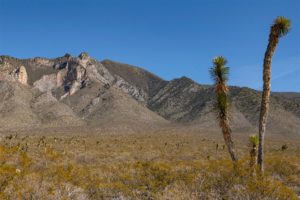
View of the Sierra El Astillero mountains where the Chiquihuite cave was found in 2012. Devlin A. Gandy
_______________________________
Unprecedented
As the adage goes, extraordinary claims usually require extraordinary evidence. More finds were needed. So Ardelean and an international team of scientists went to work by extensively expanding the excavation, beginning in 2016. They knew this would be a dangerous and difficult task. Drug cartels controlled the area.
“It was an unforgettable experience,” said Dr Mikkel Winther Pedersen, a team geneticist from the University of Copenhagen who became a lead author of the excavation project research paper. “It is a very unsafe place to travel so we were accompanied by Mexican police officers in armored cars to the foot of the mountain. We left before sunrise to climb up to the cave so that we weren’t spotted.”* Additionally”, Pederson continued, “everything from water to food as well as sampling equipment had to carried up by us and 50 donkeys in order for us to stay at the excavation without having to descend each evening.” In essence, for the researchers like Pedersen, it was like a cave camping expedition. But Ardelean was accustomed to this. He had already spent a number of months in the cave like this for years before other specialists like Pedersen ever set foot inside.
Covering a total area of 62 square meters, the team proceeded to meticulously and systematically dig, recording all materials, features and finds encountered in the process. Digging from 2016 into 2017, they revealed a dissected cave floor that consisted of, in profile, a ten-foot column of six distinct layers of compressed, stable sediments — perfect for defining undisturbed spatial relationships of objects and for dating the finds. In all, they recovered 1,930 stone artifacts unmistakably identified as either stone tools or fragments related to stone tool making, as well as bone and other organic material. The stone artifacts included stone cores, flakes, bladelets, modified or used debitage, scrapers, points, and adzes. The abundance of bladelets and blade fragments suggested a microlith technology , a stone tool tradition that was commonly employed by humans from around 35,000 to 3,000 years ago to fashion spear points and arrowheads across Africa, Europe, Asia and Australia. More than 90% of the artifacts were manufactured from what the researchers described as “green and blackish varieties of recrystallized limestone”**, a material that did not belong to the petrology of the cave, and thus must have been selectively acquired from areas outside of the cave. All of these factors clearly pointed to lithics in the cave showing anthropogenic modification — these stone objects were the result of purposeful, intentional human activity. Equally important, the tools represented a “lithic industry with no evident similarities to any other Pleistocene/early Holocene cultural complexes known in the Americas”.** They were unique among all other stone tool cultural traditions discovered thus far on the American continents.
_________________________________
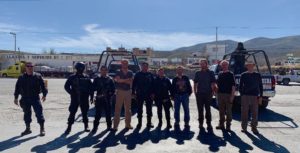
The team was escorted by armed police in protection from nearby drug cartels and gangs. Mads Thomsen
_________________________________
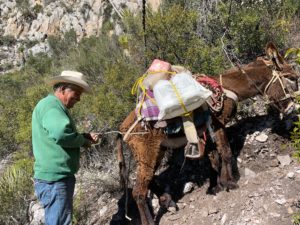
Locals with donkeys from the nearby town were hired to help transport water and food to the cave site. Mads Thomsen
_________________________________
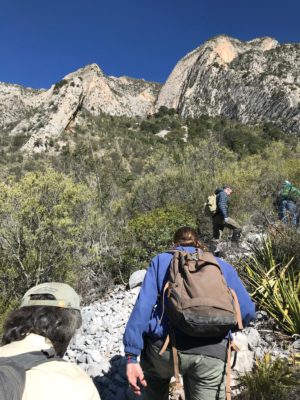
Professor Eske Willerslev, a key researcher and lead study author, and the team members ascending to the cave site which lies behind the tree line. Mikkel Winther Pedersen
_________________________________
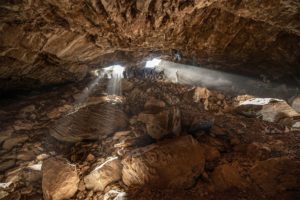
Team members entering the Chiquihuite cave. Devlin A. Gandy
_________________________________
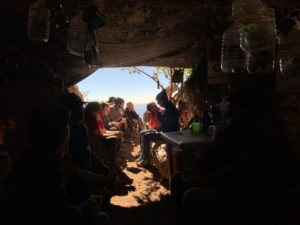
Team members eating lunch on the small platform around the Cave entrance. Mads Thomsen
_________________________________
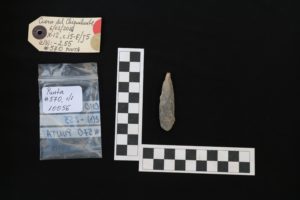
Stone tool found below the Last Glacial Maximum (LGM) layer, within Stratigraphic Component C, at Chiquihuite Cave. Ciprian Ardelean.
_________________________________
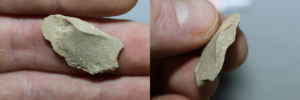
Stone tool found above the Last Glacial Maximum (LGM) layer, within Stratigraphic Component B, at Chiquihuite Cave. This particular piece was made from a greenish crystallized limestone, typical of the Chiquihuite assemblage. Ciprian Ardelean.
_________________________________
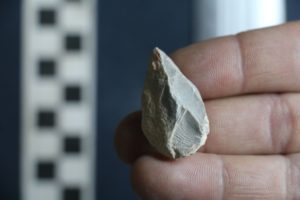
Stone tool found below the Last Glacial Maximum (LGM) layer, within Stratigraphic Component C, at Chiquihuite Cave. Ciprian Ardelean.
_________________________________
How Old?
As exciting as the artifacts were, however, the researchers knew that none of this would have as much meaning without knowing or confirming when they were produced and used. Were any of these stone tools in this expanded excavation as old as those found in the earlier 2012 test pit? To determine this, they employed both radiocarbon and OSL (Optically Stimulated Luminescense) dating to bone, charcoal, and sediment samples taken from the excavation area, ensuring that sampling was spatially tight with the artifacts to assure association integrity of the artifacts with the sampled context. Using radiocarbon dating as their primary dating tool, they obtained 46 determinations from a total of 59 samples, and 6 OSL determinations as an independent control group from 8 samples. The confidence level for the dating accuracy and reliability among the scientists was high. Said Pedersen, “This is a very precise method for age estimation and often provides an age with a -+50-year accuracy…….samples of bone or other organic material found in the layers from top to bottom were dated, which provided a highly detailed chronology for all the layers.” Aside from the stone tools and some possible evidence of controlled burning within the cave, chemical residue analysis of the sediment also yielded data that suggested human activity within the cave.
The results of the dating?
Focusing on the oldest layers, the data suggested that humans were occupying the cave between 25,000 and 30,000 years ago, with the earliest artifacts dated to about 27,000 years ago — well within the LGM, when glaciers covered much of the American continent.
The Paleoenvironment
While much of the North American continent was covered with glaciers between 20,000 and 30,000 years ago, the image of a stark landscape characterized by ice and snow was not what the early inhabitants of the Chiquihuite Cave were likely experiencing, based on the data recovered by the research team. “The view from the cave entrance today overlooks mountain slopes covered by pine and different species of Yucca such as Joshua trees,” said Pedersen. “There is also a great look over parts of the valley and in the background you see the other mountains surrounding the valley.” Between 25,000 and 30,000 years ago, for the ancient hunters who sojourned here, the scene would have been similar, affording them a strategic view of the landscape and its game below. But there were a few differences. “From our findings,” Pedersen continued, “it seems to have been more forested which coincides [with a] climate [that] would have been colder……at times there would have been quite a bit more precipitation.” Inside the cave, a variety of fauna and flora thrived, or at least made their way into the cave over time.
To piece together this picture, a team of geneticists conducted eDNA analysis on the cave sediments. They donned full-body suits, including masks, gloves and shoe coverings to prevent contaminant DNA from their bodies and clothes from skewing subsequent test results. Pedersen and his team of specialists used delicate sterile tools and tubes to extract samples. This careful, protective process was essential, according to Pedersen, as DNA degrades over time, hence very ancient DNA would be in extremely low concentration after many thousands of years. The team obtained 31 DNA extractions from samples taken from 15 key stratigraphic units. They brought all samples back to the Globe Institute in Copenhagen, where state-of-the-art techniques, processes and equipment were used to retrieve the DNA from the samples and computationally analyze it. The analysis results helped them to reconstruct the paleoenvironment, indicating that the earliest dated periods featured a mixture of forest plant species such as junipers, firs, pine, spruce, grasses, rosins and Indian paintbrush. Through the millennia, the analysis also showed the cave was occupied by a variety of animals, including bears, rodents, birds, goats, and, of course — bats.
“Another objective was to see if we could retrieve DNA the humans may have left behind in the cave in order to determine who they were related to in the past – and hence understand where they came from,” said Pedersen. They found no human DNA — at least not within the samples taken. “This does not negate human presence at Chiquihuite Cave,” report the authors of the related study published in Nature, “as the probability of detecting ancient DNA from cave sediments has been shown to be low”.**
________________________________
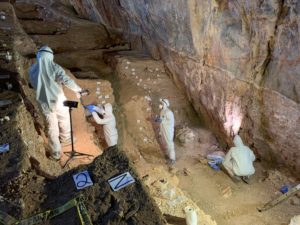
Assistant professor Mikkel Winther Pedersen with team members carefully sampling the different cultural layers in the cave. Above photo: Mads Thomsen; Below photo: Devlin A. Gandy
________________________________
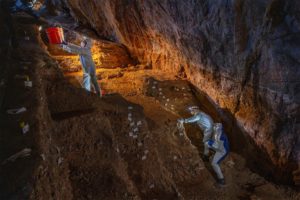
________________________________
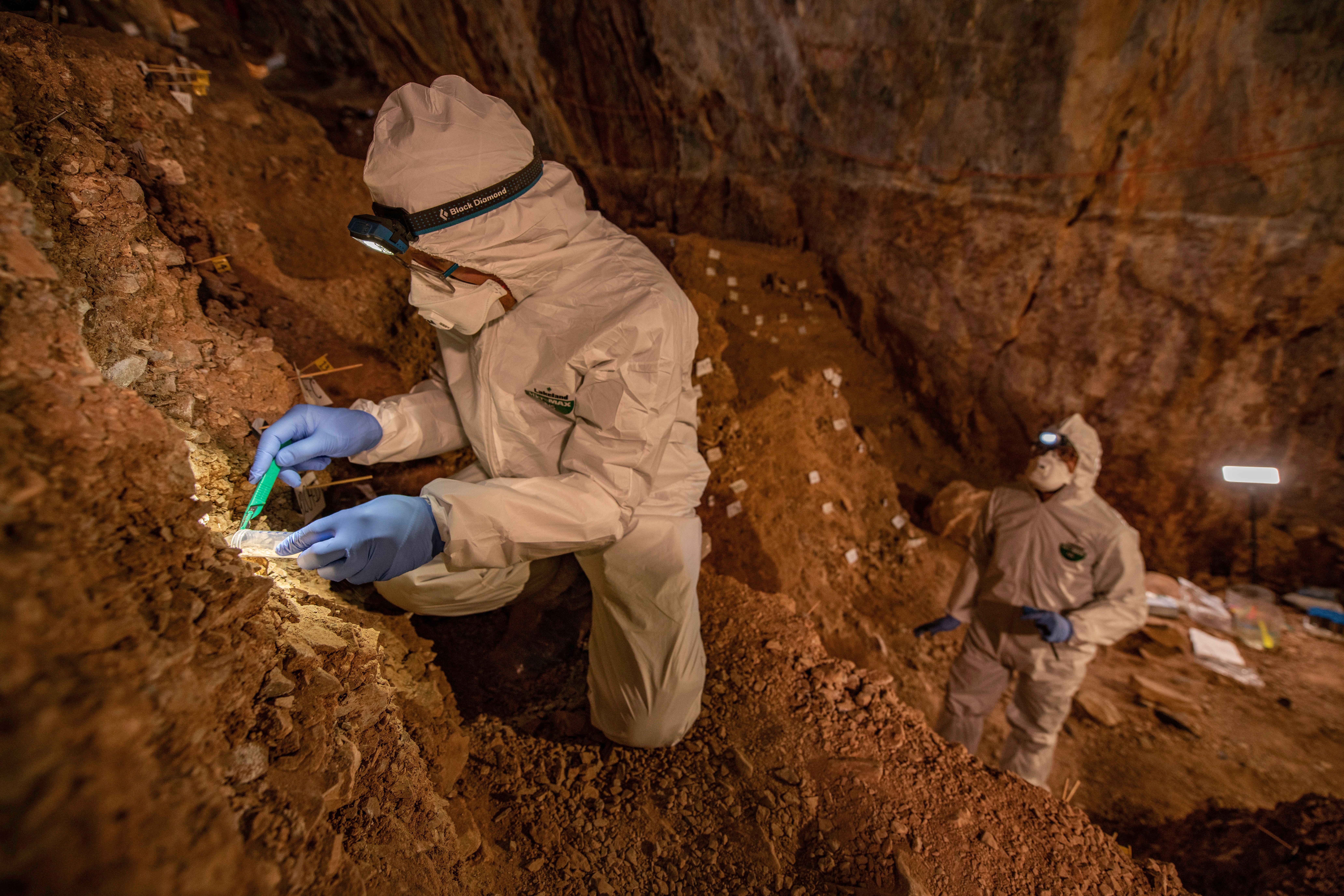
Assistant professor Mikkel Winther Pedersen from the University of Copenhagen sampling the cave sediments for DNA. Devlin A. Gandy
________________________________
Implications, and Other Sites
In sum, by combining the artifact, eDNA, and soil chemistry analysis, the researchers were able to build a preliminary albeit sketchy portrait of what was happening in this cave nearly 30,000 years ago:
Picture small bands of hunters sojourning in the cave. These were in essence nomadic campers, passing through as they moved on to new destinations. As Pedersen interprets the findings: “We think these early people would probably have come back for a few months a year to exploit reoccurring natural resources available to them and then move on…..probably when herds of large mammals would have been in the area and who had little experience with humans so they would have been easy prey.”* Therefore, the cave was not a permanent habitation place, where humans made their home year-round. They came and left through time on a periodic but persistent (“….. stone tools were found in all excavated strata.”)**basis, obviously adapted to higher altitudes and mountain environments, following the shifting game and their fortunes made in the valley below them.
But this is not the only place where possible clues to a human presence of sojourning hunters have come to light. Far to the north, at Bluefish caves in today’s Canadian Yukon, scientists have uncovered cut bone that could tell a similar story. Among other finds, they found a horse mandible and caribou pelvis that showed tell-tale signs of human-made butchery cut-marks that were dated to 20,000 years ago. “The absence of hearth features and other markers suggest that the caves were used seasonally, probably as short-term hunting sites,” wrote author Jesse Holth about the site in the article, “Bluefish Caves: The Oldest Known First Americans?”, published in Popular Archaeology. Thousands of years ago, the site would have been located just east of most of ancient Beringia, the land bridge that connected Asia with North America during the Ice Age. Old Crow Basin, also in this region of the Yukon, has yielded fossils that show possible human-caused breakage of mammoth bones dated to 25,000 to 40,000 years ago. And thousands of miles to the south and east, there are six Brazilian archaeological sites dated older than 20,000 years ago. At the Brazilian site of Toca da Tira Peia, for example, scientists uncovered possible evidence of a very early human presence, including 113 stone artifacts within five soil layers, with the lowest layer dated to 22,000 years ago. None of these sites mentioned thus far are of course without dispute. Scholarly debate will surround these discoveries, just as it will for the Chiquihuite and Bluefish caves claims.
________________________________
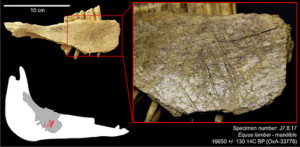
Horse mandible from Cave II at Bluefish : Cut-marks indicate removal of tongue with stone tool. Image courtesy Lauriane Bourgeon, Ariane Burke, and Thomas Higham
________________________________
If the findings at these sites and any new sites prove ultimately indisputable, the question then shifts more to searching for evidence in the paleoclimate record that might support the early dates. The broadly accepted view about when and how the first Americans entered the Americas has revolved in part around the changes in the glacial periods associated with the last glacial period of the Ice Age. During the LGM, the Cordilleran and Laurentide ice sheets covered much of Canada. However, during the warmer interglacial periods they retreated to create ice-free corridors along the Pacific coast and areas east of the Rocky Mountains of Canada. Scientists have long suggested that it was through these corridors that humans were likely able to cross Beringia or journey in stepped advances along the Pacific coast into the Americas. Exactly when and how these movements may have occurred has been a matter of debate for decades. The most widely accepted proposal has advanced the suggestion that a major entrance opportunity occurred around 15 – 16,000 years ago, after a “standstill” period (known as the Beringian Standstill Hypothesis), wherein the people who would eventually colonize the Americas spent between ten to twenty thousand years living on the Bering Land Bridge, a plain that connected the Americas with Asia during the Ice Age. Theoretically, at least some of the Beringians ventured east into the Americas when the climate warmed following the close of the LGM, the Bridge gradually becoming inundated by the melting ice and rising Bering Sea.
______________________________
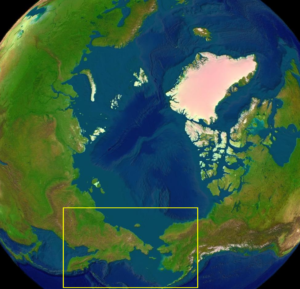
Demarcated region shows location of ancient Beringia, most of which is now inundated by the Bering Sea.
______________________________
With the results from Chiquihuite, however, Pedersen and his colleagues entertain the possibility that the ancestors of the Chiquihuite sojourners may have even entered the Americas before 30,000 years ago. With the growth of the ice sheets of the LGM commencing at 33,000 years ago, and maximum coverage not occurring until between 26,500 years and 19–20,000 years ago, pre-LGM conditions may have afforded an irresistible opportunity for early hunting bands. Those Ice Age hunters, following the migrating big game, could have eventually found themselves far east and south of ancient Beringia long before current scientists had ever thought possible.
Moving Forward
“The excavation is now closed, but the analyses continues,” wrote Pedersen to Popular Archaeology when asked what was next on their research agenda. “A lot of samples have been taken during the past 10 years and still remain to be processed. The big wish for the first samples analyzed for DNA was to identify the DNA from these ancient humans. While this hasn’t been found yet, we are still working on finding it and hopefully [we will] be able to identify who these people were related to.” In addition, future researchers will need to take another, closer look at other disputed sites across the Americas and investigate new areas and possibilities.
“We don’t know who they were, where they came from or where they went,” concludes Ardelean. “They are a complete enigma. We falsely assume that the indigenous populations in the Americas today are direct descendants from the earliest Americans, but now we do not think that is the case.
“By the time the famous Clovis population entered America, the very early Americans had disappeared thousands of years before. There could have been many failed colonizations that were lost in time and did not leave genetic traces in the population today.”*
Clearly, if the very early findings made at Chiquihuite and other sites in the Americas hold up after additional scrutiny, including new investigations and discoveries, mainstream scholarship may need to rethink how and when the first Americans arrived, and, equally intriguing — determine who they were.
_____________________________________
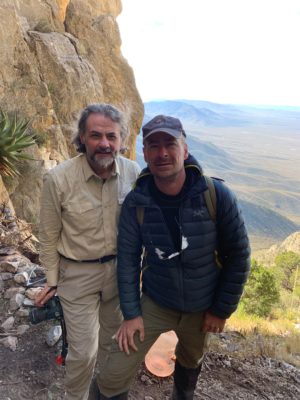
Professor Eske Willerslev and professor Ciprian F. Ardelean at the entrance to the cave. Mads Thomsen
_____________________________________
*Humans in America as much as 30,000 years ago, suggest scientists, Popular Archaeology, July 22, 2020.
**Ardelean, C.F., Becerra-Valdivia, L., Pedersen, M.W. et al. Evidence of human occupation in Mexico around the Last Glacial Maximum. Nature 584, 87–92 (2020). https://doi.org/10.1038/s41586-020-2509-0
_____________________________________
Advertisement

